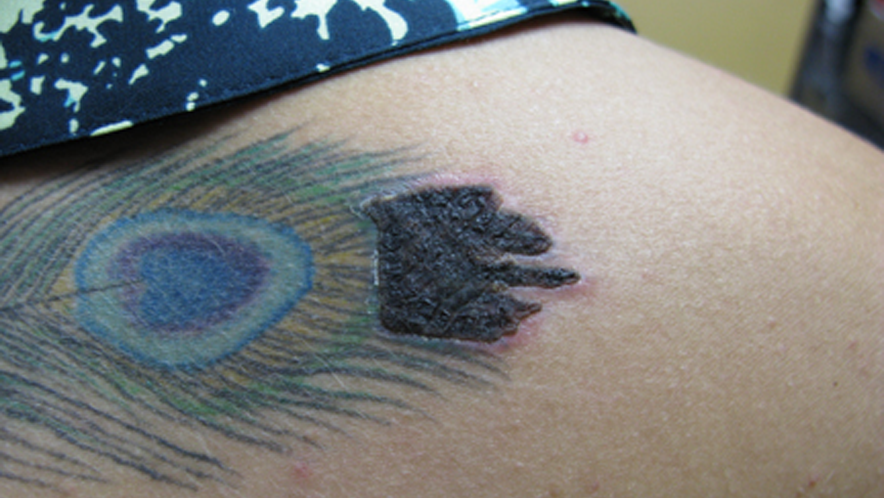[:en]
Here we provide an overview of the main tattoo removal treatments currently available, the EU legislation applicable and what is to be expected after this type of anesthetic treatment.

The procedures we are going to describe are widely referred to as "tattoo removal". This is mainly because the complete "removal" is the desired end result the clients expect from these aesthetic procedures. In reality most tattoos are very resilient, and most treatments currently available require a number of treatments in order to achieve satisfactory results whenever feasible. Because the most popular tattoo removal procedures rarely lead to the complete disappearance of the tattoo within one session we would rather refer to most types of "tattoo removal" procedures as "tattoo fading" because most of the treatments available can only realistically fade the tattoo slightly after each session instead of removing it. As we will see in some cases complete removal is not feasible without leaving some scars or some sort permanent skin texture modification.
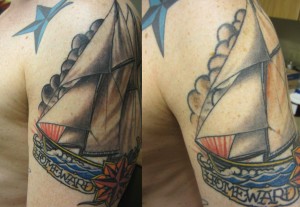
Slight fading after only one mild laser treatment. Most popular "Tattoo Removal" procedures can only fade the tattoo slightly after each session.
Most of the popular treatments currently available can only fade the tattoo slightly after each treatment. For this reason most procedures advertised as "tattoo removal" should be referred to as "tattoo fading" instead. Currently only very invasive treatments can guarantee complete removal within one procedure or session only. However after making this clear distinction in terminology, we may refer to "tattoo fading" procedures as "tattoo removal" to align to the normal terminology used on the current aesthetic market place.
Sometimes, due to the type of pigments used, it may be detrimental to try and remove the tattoo completely as doing so could require the client to undergo too many treatments. Sustained exposure to some of the most popular treatments for tattoo removal procedures (especially laser treatments) can become detrimental to the skin due to the repeated deep burns caused and therefore if the desired effects are not achieved after a few sessions then it may be advisable to discontinue the aesthetic treatments. In case where the degree of tattoo fading is too low, the likelihood of incurring into the adverse effects of these aesthetic treatments may not be worthwhile and therefore the fading treatments should discontinued or switched for others (e.g. Tattoo Excision or Tattoo Cover-up).
This section was last edited in April 2016. For official references please refer to current legislation and relevant professional legal advisers.
Tattoo drawing although have potential side effects (including infections) and these procedures involve purposely modifying the dermis by injecting the pigments inside it, while causing an open wound, tattoos made for aesthetic and lifestyle choices are not considered to be medical applications (non medical intended uses). Tattooing procedures are currently carried out by tattoo artists who are not required to hold any formal medical qualification.
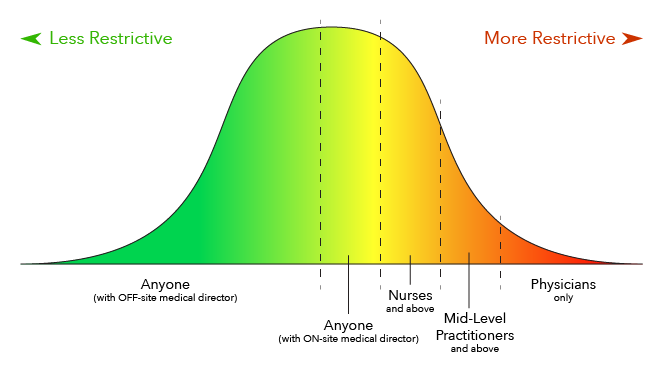
Both current legislation in Europe and the UK in particular do not dictate the type of qualifications the tattooist or tattoo removal practitioner should hold to perform this procedure. Therefore, in the UK virtually anyone can start a tattoo removal business regardless of qualifications. However some insurance companies will insist the tattoo removal practitioner holds a certain level of formal qualification.
In case of tattoo removal, although when advertising, several clinics refer to them as "medical procedures" and the client is also often referred to as "patient", from a mere legislative view point tattoo fading procedures (that do not involve surgery i.e. excision) are considered aesthetic procedures. Furthermore the current interpretation of European legislation considers tattoo fading procedures as cosmetic/aesthetic applications. This is because the main reason behind a tattoo removal procedure is the fact that the client regrets their previous tattoo, and desires to either change it or remove it completely. Of course there are no medical reasons in order to have an aesthetic tattoo drawn in the first place, likewise there are no medical reasons beyond an aesthetic tattoo removal process.
For these reasons in Europe any tattoo removal procedures are widely regarded as mere aesthetic procedure. Since early 2000s, there have been several lobbying pressures in order to modify the legal status classification of tattoo fading (tattoo removal) procedures in general, in order to be regarded as medical applications (Medical Intended Uses). As we know almost any tattoo removal processes do require to inflict a burn or a purposely inflicted injury of tattooed area in some way in order to fade or remove the pigments which reside inside the dermis. In case of tattoo fading techniques, this is done a number of times in order to accomplish the desired effects. Both tattoo parlours and clinics performing tattoo removal have to comply with local legislations, which may vary from country to country and region to region in each European country.
Therefore as we have seen tattoo removal procedures are considered to be non medical treatments for this reason they are not usually covered by standard health insurance policies and also they are not provided free of charge by the NHS.
Tattoos are far more easily drawn than than being removed. This is because the pigments of permanent tattoos are made in a way so that they will withstand to the test of time. However the natural body reaction to tattoo pigments is to try eliminate them, this normal physiological pigmentation absorption is normal and takes place very slowly. In other words, although all permanent tattoos fade over time, their fading rate is so slow that they can effectively be considered permanent.
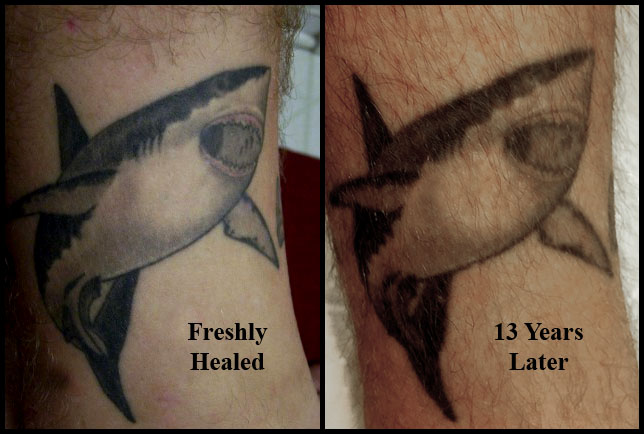
Tattoo are very resilient to the test of time because they are meant to be permanent, however they do fade slightly over time on their own accord.
The rate at which the tattoo fades over time depends on a number of factors and one of them is the type of pigments used by the tattoo artist. Different type of pigments will fade at different rates and in different ways. Also sun exposure and tanning can increase the physiological fading rate. This is because the broad spectrum of sun light also includes a small proportion of infra-red light with penetrates into the skin breaking down the tattoo pigments.
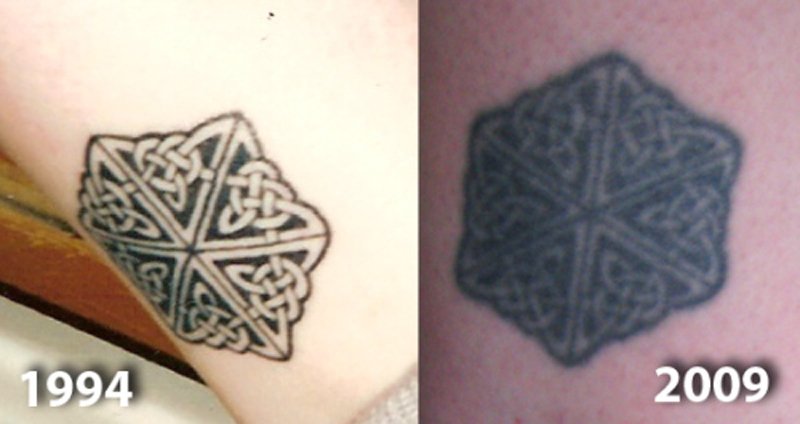
The body immune system attacks the pigments and destroy them, but this process is very slow. The discolouration over time is also dependant on the type of pigmentation used. There are more and less resilient pigments. In this picture we can appreciate how the drawing blurred over time as the edges lost their sharpness over time. This type of blurring can also be experienced after tattoo fading procedures. The tattoo fading procedures are used to accelerating the natural tattoo fading process which otherwise be too slow.
In the figure above we can appreciate the deterioration of a tattoo over time. Sometimes, this natural tattoo fading is accelerated by repeated exposure to sun light (i.e. repeated tanning). It is well known that repeated intense tanning has detrimental effects on the brightness of aesthetic tattoos over time. This is because some lower wavelengths of the broad spectrum natural sun light (in particular red and infra-red) have the effect of breaking down the tattoo pigments, in a similar fashion of lasers and IPL. However the process is much slower than the degree of fading achieved with Laser or IPL treatments. In fact what we are dong with "tattoo fading" techniques is accelerating this natural tattoo fading process one way or another.
Because the tattoo pigments are meant to be permanent and they reside inside the dermis, tattoo removal procedures are normally involving a degree of dermal treatment. Because of this, "tattoo removal" or more appropriately "tattoo fading" procedure cannot be free from inherent risks.
Due to the fact that tattoos are meant to be permanent and be resilient over time, they will generally be far more difficult to remove than having them done. One session is usually sufficient to draw a beautiful medium sized tattoo, however fading it, or even removing it completely can be very challenging and sometimes not worthwhile due to the complications involved in the complete removal of particular resilient tattoos.
One of the common questions asked by the clients is the number of tattoo fading sessions required in order to achieve their desired result (which is the complete seamless removal). It is important to manage their expectations because in many cases they do expect complete removal without leaving a trace in one or very few session only. In most cases there are no fading techniques currently known which will guarantee complete removal without leaving no trace.
Additionally not all tattoos present the same resilience when trying to fade them. Some types of tattoos can be easily removed in only a few easy fading sessions while others can be far more challenging and sometimes almost impossible to remove completely without leaving a scar, or some sort of trace (i.e. permanent hypo-pigmentation in case of laser removal) due to the aggressiveness of the treatment required for their complete removal. The amount of tattoo fading desired can be accomplished in two ways, either through relatively high number of mild tattoo fading treatments or through a few high intensity treatment sessions. Generally the better the pigment quality used and the better the devices used to draw the tattoos (achieving a relative superficial pigment distribution on the dermal layer) the easier it will be to achieve the desired results while minimising the aggressiveness or intensity of the tattoo fading treatments.
On the other hand low quality pigments or even "not fit for purpose" colours can be almost impossible to remove completely using the most popular tattoo removal techniques. In some cases, the only viable option for the removal of poorly drawn tattoos (with "non fit for purpose" pigments) can be tattoo surgical excision. Also sometimes the tattoo pigments can be injected further into the dermis closer to the hypo-dermis, this can make the removal even more challenging.
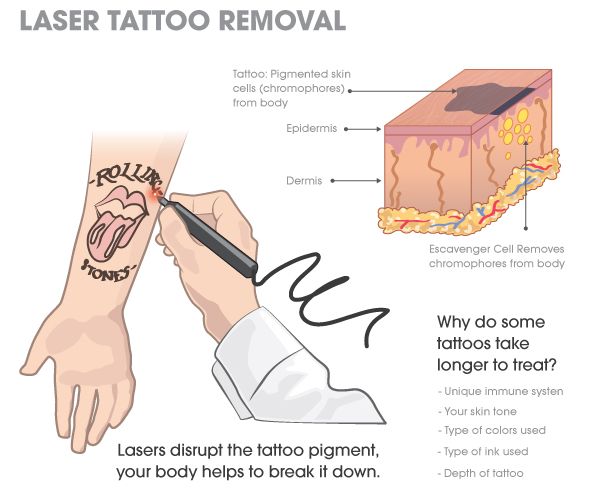
Laser "tattoo removal" is only one of the several options available for tattoo fading. Although it is the most popular option not all the tattoos will will fade in the same way. Please note that the deeper the positioning of the pigments inside the dermis, the more challenging the tattoo fading will be (see the section on the tattoo physiology for more information) .
Please note that the points below mainly apply to the most common tattoo fading procedures and unless stated otherwise do not refer to tattoo surgical excision. Generally the ease of removing tattoos depends on the following main factors:
- Depth of the pigments. The deeper the pigments inside the dermis the more challenging it will be to fade the tattoo. This applies to any tattoo fading technique. Furthermore sometimes the tattoo pigments could have been injected particularly deeply and may even be located inside or close to the hypo-dermis. In this cases it may be unrealistic to expect complete tattoo removal without leaving any trace.
- Type of pigments. The chemical composition determines the ease of removal. Additionally the better quality the tattoo pigments used the easier it will be to fade them.
- Colour of the pigments (laser tattoo fading only). Certain wavelengths can only fade certain colours. The brighter the colours of the tattoos the more challenging they will be to fade. Conversely the darker the tattoo the easier they are to fade. The wavelength used by the laser will determine the colour it fades and the number of sessions needed. Other tattoo fading treatments are colour-blind (they fade all colours indiscriminately). Most other tattoo fading options are colour blind (they fade all colours indiscriminately).
- Type of the tattoo. A non-professional drawn tattoo is usually harder to fade than professional tattoos. This is because the depth of the pigments distribution may not be uniform throughout the tattoo. Therefore the tattoo may fade in different ways depending on the depth of the pigments.
- Density and amount of the tattoo pigments. The more dense the ink, the more layers of pigments are in the tattoo and the longer it will take to fade the tattoo. What matters is how much ink is in the skin. For example cover-up tattoos have two layers of pigmentation, therefore will be harder to fade than normal tattoos.
- Area covered by the tattoo. The wider the tattoo the more fading sessions will be required to achieve the desired results. Large tattoos cannot be treated in their entirety because the risks associated to the treatment and adverse effects would be too high. In case of tattoo fading treatments which rely on burning the skin (Laser, Electric Plasma, Chemical peels etc). Exposing the body to extensive burns can be detrimental to the individual. This is because the potential risks and the likelihood of adverse reaction can increase dramatically proportionately with the area covered within the session. Additionally other tattoo fading treatments, which use other skin resurfacing principles, should not be used on extensive areas within one treatment, as this can increase the likelihood of their associated adverse reactions. Generally in case of large tattoos, they will be treated in smaller sections to manage the risks of the associated adverse effects. In case of tattoo surgical excision of large tattoos, skin grafting may be necessary to replace the large area of missing skin.
- Position of the tattoo on the body. Some areas are not suitable for certain types of tattoo fading treatments, therefore their removal may be very challenging. These are areas subject to bending and stretching (e.g. knees, elbows, underarms etc). Also those areas with will be inevitably be exposed to the constant rubbing of clothing (e.g. waist-line).
- Skin tone (laser tattoo fading only). One of the side effects peculiar to laser tattoo fading treatments if the likelihood of causing hypo-pigmentation. This is a side effect which does not generally occur after other types of tattoo fading treatments. In general the higher the treatment intensity the higher the likelihood of causing hypo-pigmentation. Conversely the lower the laser treatment intensity the lower the likelihood of hypo-pigmentation. The darker the skin tone the more the likelihood of hypo-pigmentation. Therefore when treating tattoos on dark skin tones the intensity of the treatment has to be lowered, (in order to decrease the likelihood of hypo-pigmentation) therefore increasing the number of sessions required in order to achieve a satisfactory level of tattoo fading.
- Tattoo age (laser tattoo fading only). The older the tattoo the more challenging it may be to fade the pigments. Conversely the fresher the tattoo the easier it may be to fade. This applies to laser tattoo removal, most other fading techniques tend to fade all tattoos approximately in the same way despite of their age.
- Treatment intensity. The treatment intensity of the particular type of tattoo fading treatment determines also the amount pigmentation fading after each session. Generally the higher the intensity the more the tattoo fades after each treatment. Conversely the milder the treatment the less the degree of tattoo fading after the treatment.
Estimating the number of sessions required in order to achieve the desired final results is often difficult if basing the opinion on the the key factors (above). This is because there is seldom reliable information about the way the tattoo was originally drawn, which determines the ease of fading each particular tattoo. Often some assumptions or information about the tattoo may turn out to be incorrect. In other words, the tattoo removal practitioner may not be able to establish the reaction of the specific tattoo to the fading treatment only by looking at the tattoo or asking questions in relation to how the tattoo was drawn (there is seldom reliable information on the pigmentation distribution depth, of the chemical composition of the ink used etc).
Therefore the best option to estimate the number of sessions required in order achieve the desired results is by making an extrapolation based on the degree of tattoo fading after the initial patch testing. From this information the beauty practitioner can provide a more reliable estimation of the number of sessions required to achieve the desired results.
However, even an estimation based on the degree of fading accomplished after the tattoo patch testing may not be very accurate. How much the tattoo fades after each treatment varies from treatment to treatment. The tattoo fades most after the first few treatments, this is because the superficial pigments are the most easily removed. A relative high fading is achieved by removing the most superficial pigments. Therefore those pigments that are left after the previous tattoo fading treatment are more resilient and located deeper inside the dermis.
Therefore in certain cases where the pigments left after a number of tattoo fading treatments, are very resilient and/or located too deep inside the dermis, the amount of tattoo fading will be minor after the initial tattoo fading treatments. This is because as the tattoo fades, generally the remaining pigments are those which are the most challenging to remove. In certain cases of particular resilient pigmentation, removing the fading the tattoo can become so arduous that further attempts to fade it can not only become futile but even potentially counter-productive as it only exposes the client to the adverse effects of the tattoo fading procedure without brining about any substantial improvements. In this case the further steps can be either surgical excision or tattoo cover-up.
All tattoo removal options carry potential adverse reactions and any risk associated to these aesthetic procedures can be minimised however cannot be completely ruled out even following the right procedures and the after-care protocols. As we have seen, also tattooing present inherent risks, however the perceived likelihood of adverse reactions associated to their removal are generally perceived as higher.
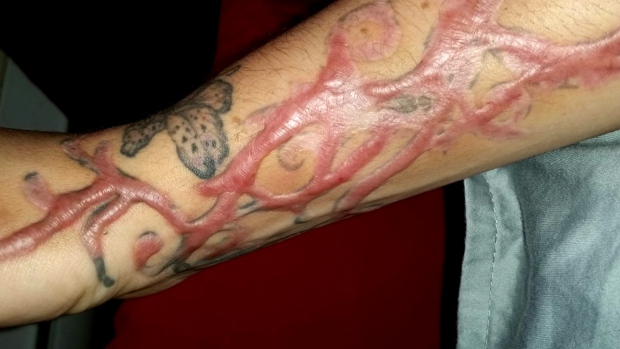
Keloidal formation after tattoo removal. Some adverse reactions cannot be avoided. This is also why it is important to carry out a patch test at consultation stage.
The reason for this is very simple: although the inherent risks of both tattoo drawing and tattoo removal are very similar, tattoo removal are perceived to be riskier procedures because, unlike tattooing, several tattoo fading treatments are often required in order to achieve satisfactory results. On the other hand, the client exposes himself/herself to the inherent risks of a tattooing only once, by contrast they will require to expose themselves to the potential adverse effects several times in order to "remove" (or more appropriately fade) them. Because of this repeated exposure to the inherent adverse effects of tattoo fading treatments, the perceived associated risks are higher in tattoo removal than the tattooing process. The risks associated to each tattoo removal or fading treatment vary dramatically according to the type of fading treatments, the way the treatment was carried out (e.g. the intensity of the treatment) and especially the after-care. Therefore the client has to go through several burns or several resurfacing treatments each time being exposed to similar side effects to those of the tattoo drawing process. It is important to emphasise that most of the permanent adverse reactions to the most popular tattoo fading techniques are usually due to the client's failure to comply with the after-care procedures.
To review the undesirable effects or adverse reactions to tattooing please Click Here.
The request for tattoo removal is currently constantly on the increase and the prices charged for this type of aesthetic procedure are high also due to the relative complexity of the tattoo removal procedures. Additionally more and more people are are highly motivated and sometimes willing to pay almost any amount to have their tattoo removed.
In the UK it is not uncommon for some tattoo removal quotes to reach 20 or 30 thousands pounds. Furthermore due to the the inherent complexity of these aesthetic treatments the tattoo removal market provides very conflicting information in connection with each type of "tattoo fading" or "tattoo removal" procedure. This is thought to be due to the several vested financial interests in "tattoo removal" procedures. Some sources point to some treatments types as being extremely risky and focus only to their potential adverse reactions of the specific type of tattoo fading treatment. Other sources emphasise the risks of undergoing tattoo removal procedures from "non qualified" tattoo removal laser practitioners by pointing out and showing only the potential adverse effects of tattoo fading procedures. However as it is well known, no tattoo fading technique potential adverse effects which can be minimised but never completely eliminated. Due to these two factors (vested financial interests and the mere fact that none of the tattoo fading options currently available cannot be considered completely risk free) there are several contrasting information on the public domain suggesting one method to be more effective or safer than others.
There are several options for tattoo removal. In this website we will explore the most popular ones first. Some of the most common tattoo fading treatments involve essentially skin resurfacing techniques (is laser, plasma/electrical arcing, microdermabrasion, cosmetic peels etc). These techniques although sometimes slowly, will lead to a certain degree of tattoo fading, however the problem with skin resurfacing in tattoo removal is that the tattoo pigments are located inside the dermis therefore the resurfacing treatment has to involve the dermal layer in order to be somewhat effective. Any skin resurfacing which involves the dermal layer has intrinsic potential adverse effects including scarring. The type of skin resurfacing dictates the types and prevalence of the potential adverse effects.
This is one of the most popular options available on the market. This is heavily advertised the world over and used in several cosmetic clinics. This method relies on skin resurfacing of the dermal layer (by causing a controlled burn). Essentially the tattoo pigments as well as the dermal layer are targeted by the laser causing part of the pigments to be reabsorbed. For more information about laser tattoo removal or laser tattoo fading please Click Here.
This a technique which has been used for several years particularly in Italy and Germany and has been in use for several years in many European aesthetic clinics with very good consistent results. It combines the use of salation and thermabrasion. The thermabrasion can be carried out by using devices generating electrical arcing or certain radio frequency devices which have the same ablative (burning) effect. Devices for this intended purpose have been on the market for the past 40 years. Today there are even several more devices on the market and this technique is increasing in popularity throughout Europe. Although very effective, this tattoo fading technique is not as popular as laser tattoo removal (fading). If carried out appropriately this tattoo fading treatment generally accomplishes a greater degree of pigmentation fading than most other techniques. For more information in connection with this type of procedure please click here (link to be later updated, by the 20ieth of September 2016 ).
In the video below we can watch a part of the surgical procedure for tattoo excision. The practitioner removes the tattoo using a scalpel and closes the wound with stitches.
Surgical excision, also referred to as "surgical tattoo removal", is one of the most invasive options for "tattoo removal" when compared to the most popular tattoo "fading" procedures. However, this is the only procedure which can effectively be referred to as "tattoo removal". This is because only "surgical tattoo removal" can guarantee the complete removal of the unwanted tattoos within one session. All the other non surgical aesthetic treatments are mostly less invasive, however they can only fade the tattoo but seldom remove it completely within one session.
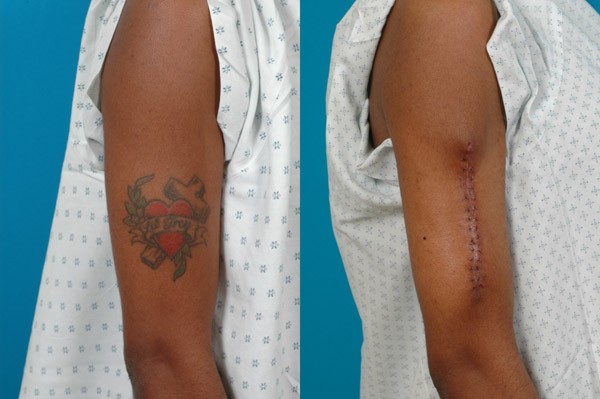
Example of tattoo surgical excision. As we can see the tattoo is not in an area especially prone to stretching and bending. In this particular case the tattoo, although relatively large for an excision, is positioned on the upper arm where there is usually a certain amount of loose skin which can be removed, without causing undesirable "skin pulling" effects. We can appreciate the typical scar characteristic of a surgical excision.
Before suggesting "tattoo surgical excision", the practitioner assesses the area in order to have a clear appreciation of how the part would look like if the skin where the tattoo resides were removed completely. If the "pulling effects" of the surgery is not dramatic or would not impair normal movements (hence, apart form the scar, the final result would practically look seamless), then the the procedure is carried out under local anaesthetic. This is the only tattoo removal procedure which requires local anaesthetic, for all the other tattoo "fading" treatments topical numbing products usually suffice for the comfort of the client. In some cases where the tattoo covers a large area, this procedure may not be recommendable as removing large portion of the skin could be detrimental and would sometimes require subsequent skin grafting.
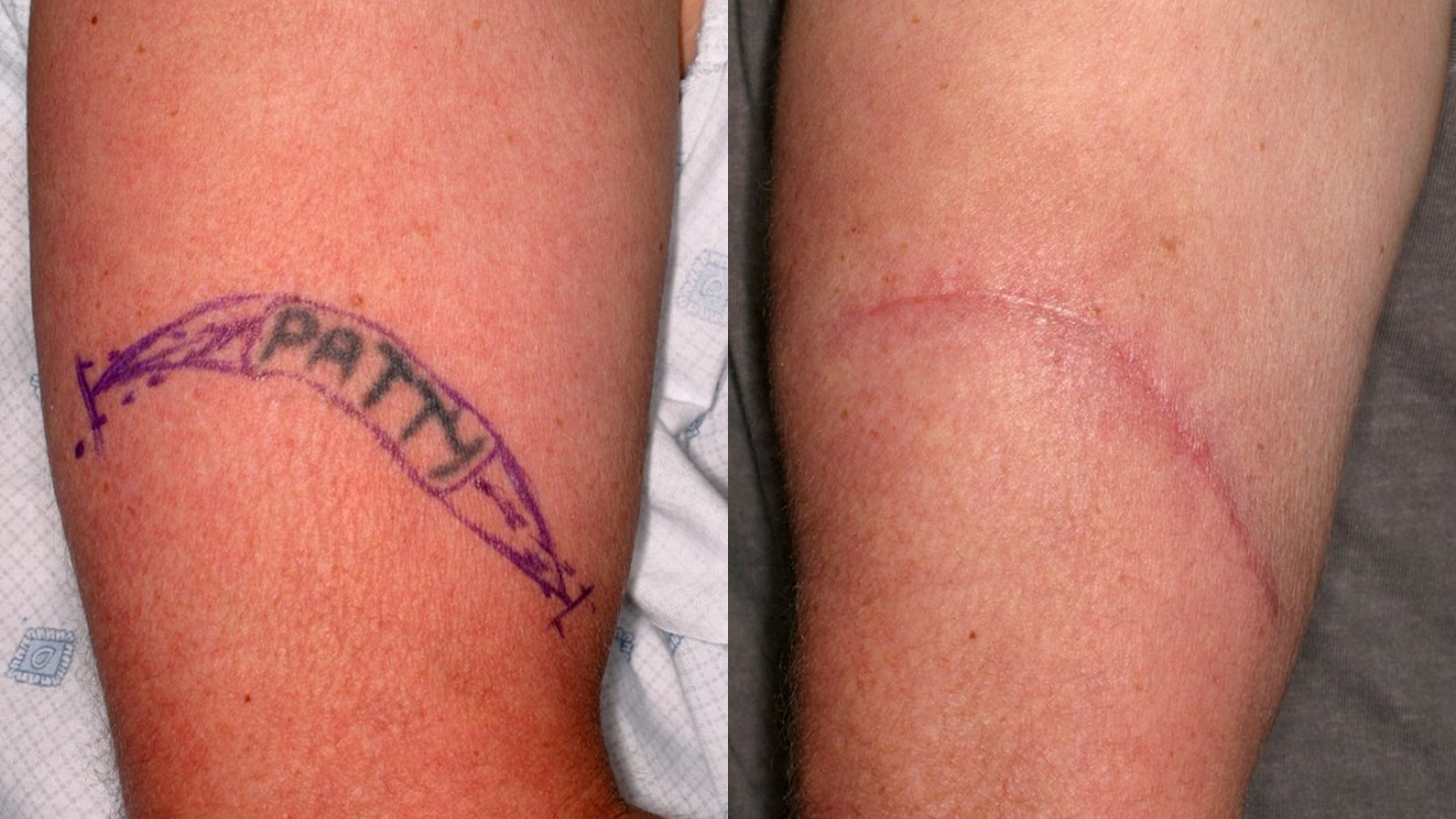
The best candidates for this type of surgical procedure are relatively small tattoos, which are not located in areas particularly prone to bending and stretching. The tattoo in the picture is relatively small and not located in a critical area of the body. Surgical removal of large portions of the skin could be detrimental to the individual and should be avoided.
Not all tattoos are the best candidates for this type of procedure. If they are located on the face or areas where the skin is subject to bending and stretching (i.e. elbows, knees, shoulders etc) then this procedure may not recommendable. Specifically, this procedure should be avoided close to the major joints were a certain degree of skin stretching is required for normal movement. The main problem with removing large tattoos using surgical excision is the fact that the skin will be "pulled" and the effects of the procedure could be clearly visible long after the removal (non seamless results). One of the disadvantages of this type of procedure is that it will almost inevitably leave a certain degree of scarring caused by the sutures. Therefore if the tattoo is on the face, the skin constriction caused by the surgery and the scar left by the sutures do not make this type of procedure the most recommendable. Small tattoos are the best candidates for this type of procedure especially if they are located in areas where there is a relative amount of loose skin which can be removed without subsequent need for skin grafting or the skin can be removed without causing ad major "pulling" effect which could make the area look awkward.
This surgical technique proves highly effective in removing certain types of tattoos where the presence of a small scar will not bee very important. some tattoos and allows the surgeon to remove the inked areas with great precision and within one sitting only.
Advantages of surgical tattoo excision.
The main advantage of excision is that the tattoo will be gone immediately after the surgical procedure. This is generally the most cost effective option for smaller tattoos. This procedure although invasive, offers the clear clinical advantage of avoiding multiple exposures to burns and other intrinsic adverse effects of most common tattoo fading procedures. Because only one procedure is required for the removal of small tattoos the cost of this type of procedure is typically lower than other tattoo fading procedures.
Adverse effects.
Side effects are generally minor, but may include:
- Some degree of scarring due to the sutures is to be expected and cannot be avoided.
- Infection could occur if the area is not looked after properly.
- The skin may feel tighter for a while after the procedure due to the missing skin.
- In certain cases, where large tattoos are required to be removed using this surgical procedure, skin grafting may be necessary. The removal may not be seamless if the skin removed is relatively large (also costs could increase dramatically).
Estimated cost.
The cost of this type of procedure is generally lower than most common tattoo fading treatments. This is mainly because the cost of tattoo fading techniques is cumulative and several treatments are required to achieve satisfactory results. In case of surgical tattoo excision of small tattoos one session will suffice to remove the tattoo. The cost for surgical tattoo removal depends on several factors:
- Country where the procedure is carried out. In certain countries the wide availability of surgeons can make this procedure more cost effective than other most popular tattoo fading treatments. Tattoo fading devices can sometimes be very costly, making the tattoo fading procedures especially "laser removal" more expensive than surgical excision.
- The size of the tattoo. The larger the tattoo the more expensive the procedure may cost due to the likelihood of skin grafting requirement. As pointed out previously, this procedure may not recommendable for the removal of relatively large tattoos.
- The type of anaesthesia used during the procedure. Local anaesthetic is the preferred and most cost effective option for this type of procedure. In case the surgeon opts for total general anaesthesia the procedure can be far more costly. General anaesthetic is the preferred option in case of tattoo surgical excision which also requires skin grafting. Unlike the other most common tattoo tattoo fading procedure topical numbing products will not suffice for surgical procedures.
Due to its effectiveness, the basic principles of salabrasion (combination of osmosis and dermal abrasion) have been used for several hundreds years and this makes it one of the oldest form of tattoo fading procedures currently known. While the efficacy of other methods may be limited by the age of the tattoo, the pigments colours (in case of Laser tattoo fading), the type of tattoo pigments and their distributions inside the dermis, the Saline Method (Osmosis) can remove both old and new tattoos regardless of pigments used. This method is also effective on amateur, professional grade tattoos and permanent make-up, however it cannot fade very deep pigments close to the hypo-dermis.
Additionally, since the saline method does not rely on the destruction of skin layers, the risk of scarring (although always exist and can never be ruled out) is considerably lower than more traditional methods. Finally, pain and wait time between treatments is decreased when compared to laser treatments. Where blistering is a normal inevitable adverse reaction to the burn caused by the Laser, it is not experienced after salabrasion. The evidence of the efficacy of Salation (referred to as salabrasion, or osmosis) is corroborated by fact that the degree of tattoo fading is relatively predictable and the results are repeatable. The efficacy of osmosis is also validated by various scientific research papers (view further reference) and studies carried out by radio frequency devices manufacturers. Reference.
The techniques and protocols used with salation (or osmosis) have evolved throughout the years due to the different skin resurfacing devices that had been placed on the market over time or novel skin abrasion techniques. Also the fact that in Europe and in most parts of the world tattoo removal is a not a heavily regulated procedure have helped develop different protocols for this application. Osmosis (or Salabration) is a tattoo fading technique because it leads to a degree of pigmentation fading after each treatment and complete removal cannot be guaranteed within one treatment.

Sodium Chloride (salt) induces osmosis and fades any tattoo colours very effectively (for this reason this type of aesthetic procedure is referred to as "colour blind"). Osmosis has to be combined with other types of skin abrasion treatments to be effective.
The main ingredient of this type of tattoo fading technique is Sodium Chloride (salt). The reason for this treatment to be effective is the fact that the osmosis induced when salt (Sodium Chloride) is placed on top of the tattoo pigments, it has the direct effect of drawing not only more water molecules towards it but also the broken tattoo pigments with it.
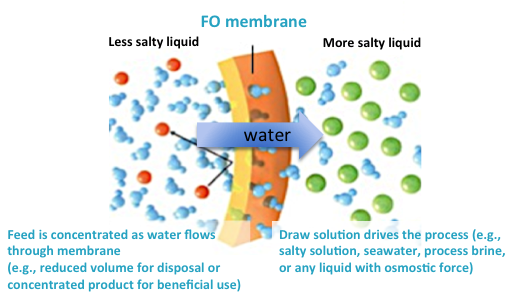
This figure illustrates the general physical principle of the osmotic process. Water tends to move towards the more saline solution. With osmosis in tattoo removal the water is drawn towards the highly concentrated saline solution. This also allows the broken free tattoo colour pigments to be drawn towards the sterile saline solution or the sterile fine salt.
Applying salt on its own on a tattoo does not have the desired tattoo fading effects. This is because the tattoo pigments are well ingrained inside the dermis and are protected by the epidermis. Therefore merely trying to apply osmosis without another skin abrading treatment which facilitates the osmotic process is not going to produce the desired tattoo fading effects. In other words, if used on its own, the application of sodium Chloride on the surface of the tattoo has very little effects on the tattoo pigments.
For this reason this type of procedure is usually split into two parts:
Abrasion. A form or dermal abrasion is required to allow the dermis to become in contact with the sterile saline solution or fine sterile sodium chloride, this will facilitate the osmotic process to take place. Abrasion can be carried out in many different ways, the most popular techniques use mechanical means, like abrasion by using dermal abrasion devices, micro dermabrasion devices. Thermal dermabrasion by using radio frequency devices or electrical arcing devices are also used to facilitate osmotic tattoo fading. Only these techniques are are explored in this website because these are the most common methods used for this application. However abrasion can be carried out in several other ways to facilitate osmosis. Also thermal abrasion may be possible using other devices including lasers, however they will not be explored here. Local anaesthesia (which is non mandatory) is sometimes administered before the dermal abrasion treatment to avoid discomfort. Good topical numbing products are the preferred option for salabrasion, are more cost effective, easier to use and generally suffice for this purpose. If using dermabrasion devices the tattooed area is abraded until the area becomes red or starts to bleed slightly. Likewise if using thermadermabrasion using radio frequency or Electrical arcing-Plasma devices, the tattooed are is treated until slight bleeding takes place.
Osmosis. The basic active substance used in Osmosis is sterile fine salt. Osmosis can be applied in different ways. Sodium Chloride can be used on its own, made into a thick paste of sterile fine salt and sterile saline solution, or as a saturated or close to saturation sterile saline solution. Sometimes bandages impregnated with highly concentrated saline solution are applied on the abraded tattoo to cause the osmotic effect. The aesthetic practitioner can choose to apply the osmotic effect on the abraded tattoo in different ways and at different intensity (by varying the timing of application) depending on the area where the tattoo is located and the desired effects.
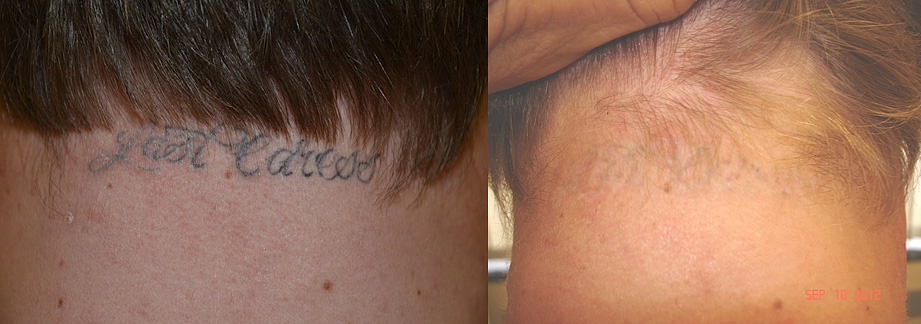
Effective use of Osmosis in tattoo removal. Reference.
As stated above the osmotic effect can be carried out by applying simply sterile fine salt and bandaging the area, or by applying bandages impregnated with high concentrated sterile saline solution, or applying a dense saline paste on the abraded tattoo etc. The way osmosis is applied is often dictated by the location of the tattoo and the preference of the aesthetic practitioner. For example, when removing permanent make-up, bandaging the area or applying fine salt may not be convenient, whereas applying a thick paste for a few minutes (typically on the tattooed eyebrows) maybe the most convenient option. The osmotic effects depend on the type of abrasion carried out before the osmosis was applied, timing of osmotic application and the type of application (i.e. whether fine sterile salt is applied, a saline paste, saline solution impregnated bandages etc). Varying one of these parameters determines the intensity of the treatment and the amount of pigmentation removal of the specific tattoo fading session.
The duration of the application will also determine the intensity of the osmotic treatment and the degree of tattoo fading. Osmosis can be applied from ten minutes to two hours depending on several factors. In order to stop the osmotic effect, the area is washed using the appropriate antiseptic and re-bandaged. The bandage should be removed a few hours later and the area washed again using the appropriate antiseptic and the bandaging process repeated every 5 to 6 hours for at least 24 hours. Three to four days after the procedure scabs start to develop. The scabs must fall off on their own. Every time the area is treated there will be a degree of discolouration of the tattoo.
There are several factors that contribute to the degree of tattoo fading after each treatment using this technique:
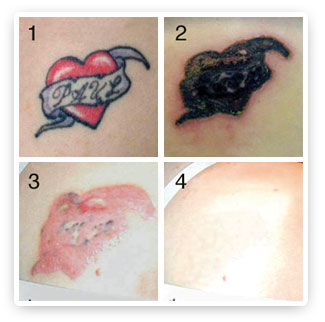
Original tattoo (1), the typical scabbing on the top right(2), post treatment temporary hypertrophic formation (3), skin retuned to normal after the complete removal (4).
- Depth and type of abrasion. Whether the abrasion is carried out mechanically, using thermal abrasion devices or radio frequency devices. The deeper the abrasion the stronger the osmotic effects. Certain types of abrasion may be more effective than others. Thermal abrasion for instance has the double effect of causing the abrasion but also breaking down some of the pigmentation due to the heat induced into the skin.
- Timing of the osmosis application. The longer the saline solution or the saline paste is kept on the abraded tattoo the better the osmosis effects and the more the eventual discolouration.
- How the osmosis has been applied. Namely it is possible to apply fine sterile salt or sterile paste or a highly concentrated saline solution. Keeping all the other parameters the same (i.e. timing of osmosis application type of and depth of abrasion etc) and changing the way the osmosis is applied, its efficacy in fading the pigments vary.
- Depth of the tattoo pigments. The deeper the pigments the more arduous will the complete removal be or even achieving acceptable results.
- Type of pigments. Like with any other tattoo fading treatment, inevitably the quality of the pigmentation determines the ease of tattoo fading.
Alternative saline treatment.
Certain aesthetic practitioners also utilise traditional tattoo equipment that is commonly used to draw the tattoo. Instead of tattoo pigmentation, a highly concentrated saline solution is injected into the tattoo. The highly concentrated sterile saline solution effectively bonds to the pigment molecules trapped deep below the superficial layers. The body naturally recognizes these bound pigment particles and pushes them up toward the surface of the skin, eventually ejecting them and causing the area to scab and the tattoo to fade.
Dermabrasion has been conceived for other aesthetic procedures, in particular for skin resurfacing used to improve the appearance of fine lines. Sometimes microdermabrasion is used for tattoo fading. There are several types of dermabrasion devices on the market.
This technique when used for tattoo fading, is also referred to as "sanding off" the tattoo. This method uses skin resurfacing in order to fade the tattoo. This aesthetic procedure can be used on its own or combined with other procedures (i.e. salation or osmosis).
On its own, this procedure focuses on stimulating the skin regeneration process by sanding off the epidermal layer, and in case of tattoo removal also the upper part of the dermis where the tattoo resides. This is not a very popular tattoo fading method, particularly due to its immediate gruesomeness (the treated part will in fact immediately start to bleed), the relative low degree of tattoo fading after each session and hence the fact that several treatments are required in order to to achieve the desired results, (consequently exposing the client to the intrinsic associated adverse effects of this treatment several times). Because of these reasons microdermabrasion on its own is not widely used for tattoo fading treatments. After each session scabs will form and the tattoo should have faded slightly.
Although this is not a tattoo popular tattoo fading technique on its on, it is often used in conjunction with salabrasion (or osmosis) with improved degree of tattoo fading after each treatment.
In the video shown below the resurfacing is carried out mechanically. Bleeding during this type of treatment is a normal and physiological consequence of the treatment and can be gruesome to watch.
Like dermabrasion, this is a technique which relies on skin resurfacing. There are several types of chemical peels that can be used for this application. The main problem, like with the use of any other skin resurfacing techniques, is that although the cosmetic peels can remove skin layers as deep as required, the pigments do not fade like the mainstream tattoo fading techniques (Plasma and osmosis, Osmosis on its own, Laser). The reason is that in order for this technique to be effective the ablation should be carried out to remove part of the dermis where the tattoo pigments reside. As we know the deeper the ablation into the dermis the more likely the risk of causing permanent hypertrophic scar formation. Also the fading results are not very consistent using this method as the ablation effects depend on the application of the particular peeling product.
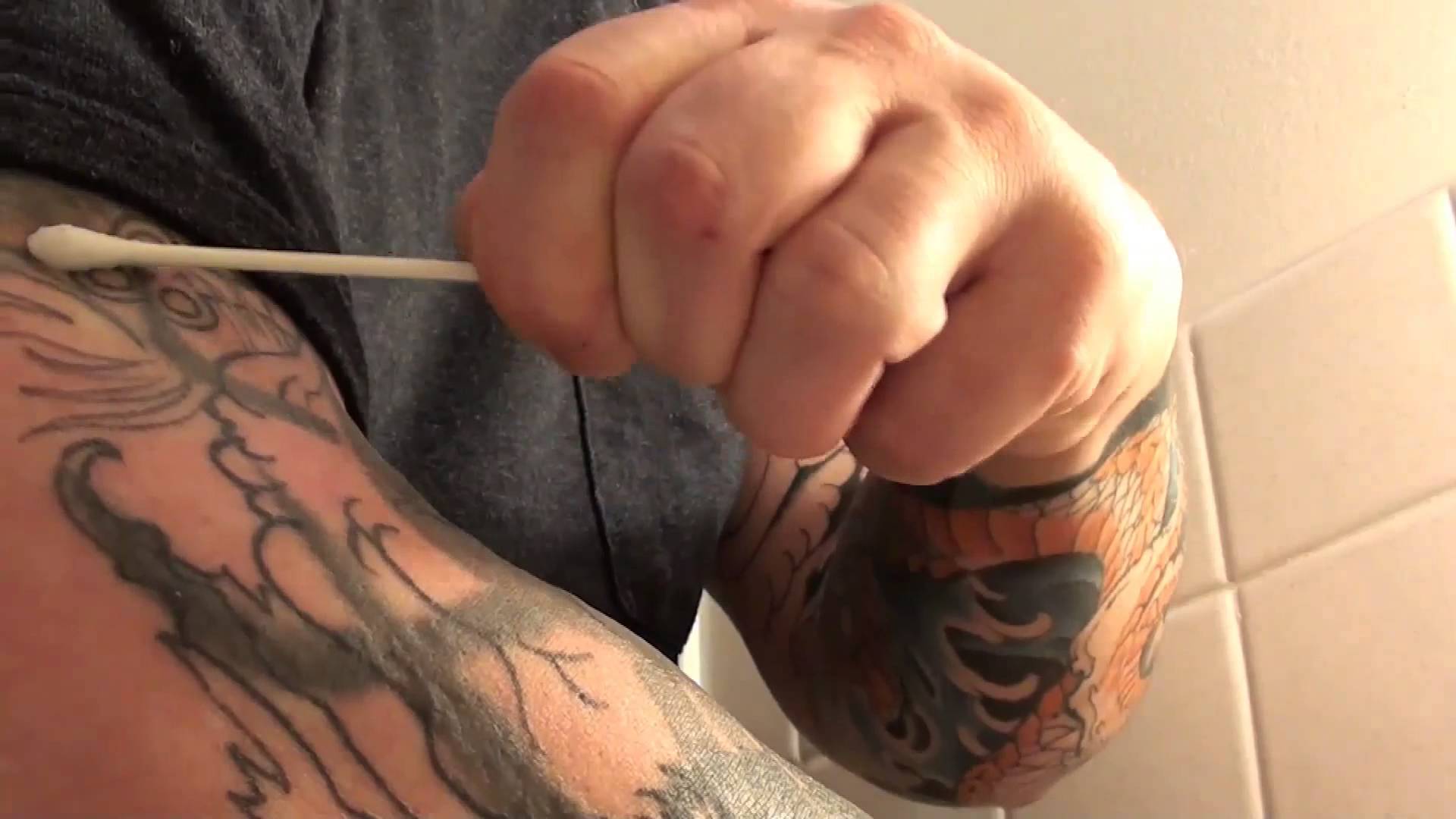
TCA is one of the peels advertised for tattoo removal. Also peels for tattoo fading are advertised as home tattoo removal treatments. There are several articles warning about the risks of such home treatments, referring to them as risky, however as we know all tattoo fading treatments do all have potential adverse reactions. It is believed this is a reaction to the low prices of these home treatments threatening the mainstream business of major cosmetic clinics. To view the video associated to this picture click here.
Intense Pulsed Light devices are mostly used for permanent epilation and they are very rarely used for tattoo fading. The main difference between lasers and Intense pulsed light (IPL ) is that in case of lasers the device can emit one or multiple wavelenths at once, while in case of IPL the device emits a broad spectrum light. The IPL device's broad spectrum light which penetrates into the skin and can fade the tattoo pigments. This is because the broad spectrum light breaks down part of the tattoo pigments. This is a similar process to laser tattoo fading.
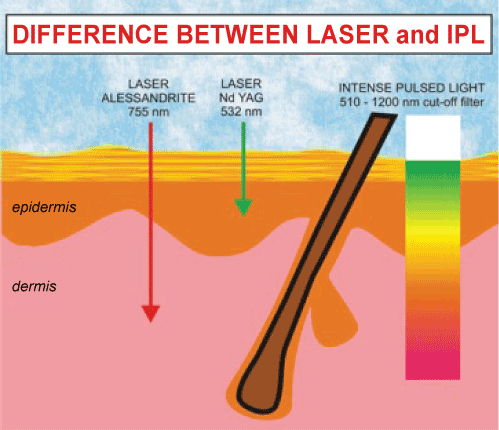
This picture illustrates the basic difference between Lasers and IPL Devices. Lasers can emit at one or multiple frequencies. IPL devices, instead emit a broad spectrum light. The frequencies emitted vary from device to device and are specified by the manufacturers. Also this diagram illustrates how the higher the radiation frequency is absorbed by the more superficial part of the skin (green and yellow) while the low frequencies penetrate deeper into the skin (red and infra-red).
As we have seen previously repeated sun exposure is attributed to the premature fading of tattoos. In case of IPL devices some of the wavelengths used penetrate deeper into the skin than the sunlight does therefore being far more effective than normal sun exposure in the fading of the tattoos. Those particularly prone to developing scars or keloids should not undergo tattoo fading treatments in general, including IPL treatments because of the increased likelihood of permanent adverse reactions. Consult a specialist before undergoing IPL treatments to assess your possible skin reactionm this is usually done by performing a patch test; the test area should be watched for redness, blistering, pigment issues, rashes, later scarring and keloidal formations.
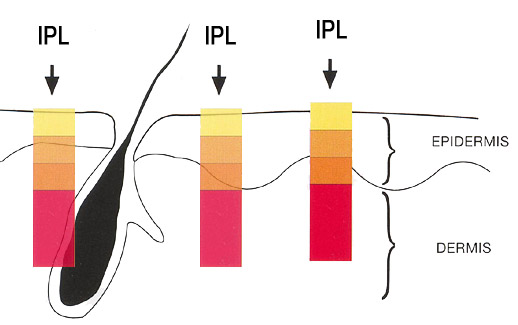
This picture is useful because it illustrates how the broad spectrum light of the IPL is absorbed by the skin. The higher frequencies (represented by the yellow light) are absorbed by the most superficial layer. The lower frequencies (represented by the orange and red) penetrate into the deeper layer of the skin.
Before performing the IPL tattoo fading procedure, the beauty practitioner may administer a topical numbing product. A cold gel will then be placed on the area and a glass prism is applied to channel the intense light. Several treatments will follow every 3-4 weeks, all more aggressive than the first.
The skin will be pink or red after the procedure. Side effects from IPL include blistering, small bleeding, scarring, swelling and changes in pigmentation. Sunscreen with high SPF must be used on the treated area.
Cryotherapy uses very cold temperatures to remove unwanted tissue. Like IPL, this is very rarely used for tattoo fading and it is not a mainstream treatment. For tattoo removal, ice crystals form on the skin with tattoo pigments, fragmenting some of them. Cryotherapy can be carried out with liquid nitrogen, carbon dioxide, argon or a combination of dimethyl ether and propane to freeze the skin. The epidermis peels and comes off; some of tattoo ink residing underneath the skin should come off as well. Several cryotherapy sessions will be necessary.
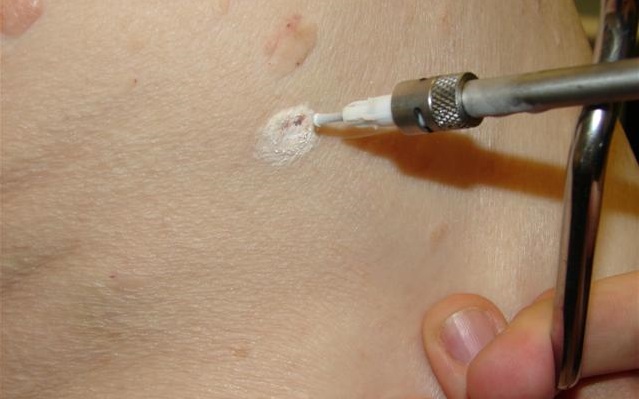
Although cryotherapy is widely used for various dermatological applications expecially warts removal, it is sometimes used for tattoo removal due to its skin resurfacing effects.
Clients may experience some pain and redness at the site, which can be attenuated by pain relieving products. Blisters go away after a few days. Small white spots may form around the area and are most likely permanent. Risks include nerve tissue damage and scarring.
As we have seen the complete removal of permanent aesthetic tattoos are sometimes very challenging. Undergoing several tattoo fading treatments can not only be expensive but does expose the client several times to the inherent potential adverse effects of each particular treatment. As we know, the best degree of tattoo fading is accomplished during the first treatments, and as the tattoo fades, the pigments remaining are the most resilient. Especially those located in the deeper part of the dermis, and sometimes even inside the the hypo-dermis. Therefore once the tattoo has faded to a certain extent, in case the further fading treatments do not achieve the satisfactory tattoo fading, than alternative treatments may be more suitable. One option may be cover up.
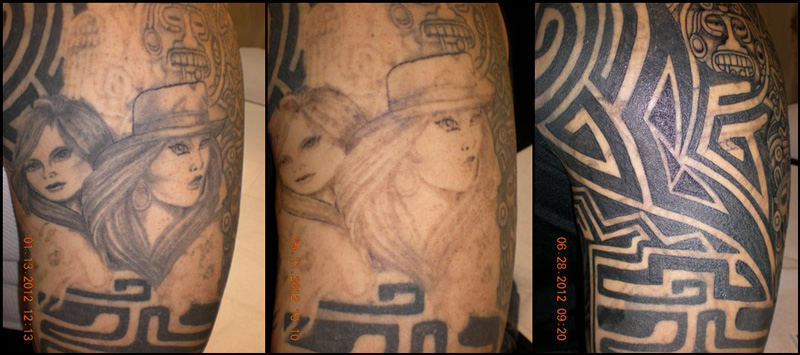
In some cases the cost and the adverse effects on the skin of tattoo fading treatment aimed at completely removing a tattoo are not worthwhile especially with laser treatments. Therefore it may be preferable to fade the tattoo as much as reasonably possible and cover it up with another. The results are quite good most of the times. In this case we can see how the tattoo fading can help cover up a previous tattoo.
Tattoo cover up can be used on an existing tattoo, without any prior fading treatment. In fact, an artfully done cover-up may render the old tattoo completely invisible, though this will depend largely on the size, style, colours and techniques used on the old tattoo and the skill of the tattoo artist. Covering up a previous tattoo requires darker tones in the new tattoo to effectively hide the older, unwanted piece. and also can be used as soon as the fading of the particular tattoo removal treatment reduce in effectiveness (becoming not worthwhile).
Many tattoos are too bright to cover up and in those cases the use of tattoo fading treatments may be advisable to lighten the existing ink to make themselves better candidates for a cover up tattoo.
Generally, the main challenge of all current "tattoo removal" or better "tattoo fading techniques" is that, due to the inherent physiology of aesthetic tattoos, the pigments reside inside the dermal layer, therefore any effective treatment will inevitably affect the dermis in one way or another consequently causing a number of inherent risks including developing scars or other side effects. Despite the type of treatment used to fade the tattoo the inherent risks of scarring and other adverse effects can be minimised but never completely eliminated due to the very nature of these aesthetic treatments. Unfortunately, despite many different claims of selective tattoo pigment targeting, there are not currently known methods that actually allow selective targeting and destruction of the tattoo pigments without also affecting the dermal layer where the tattoo resides. This is proven by the fact that the adverse reaction to the tattoo fading treatment is the same in any part of the body not covered by the tattoo. Additionally the most popular tattoo fading treatments rely on burning the skin (e.g. laser treatment, IPL, Plasma etc), therefore these treatments may carry inherent adverse effects associated to any common skin burn.
There are three types of adverse effects:
- the temporary adverse reactions, those which follow the treatment and cause the so called downtime (most of them will subside on their own accord),
- semi permanent adverse effects
- and permanent.
Temporary adverse reactions.
The type of temporary adverse reactions vary according to the type of tattoo fading treatment. These are inevitable due to the very nature of the treatments. Most of them will not require any treatment, as they will subside on their own accord. Some of others, like inflammatory infections, will necessitate treatment. These temporary adverse reactions are:
- Discomfort and pain during treatment.
- Frosting (laser treatments).
- Minor bleeding.
- Immediate redness and swelling.
- Blistering.
- Scabbing.
- Itching.
- Swelling and infections.
 While a lot will depend on the individual pain threshold, it is fair to say that the majority of people undergoing the most popular tattoo fading treatments experience discomfort and pain if the appropriate numbing product is not applied on the tattoo in advance. The level of discomfort and pain also depends on where the tattoo is located and the type of tattoo fading treatment; tattoos on more fleshy areas of the body will hurt less as the flesh acts as a cushion, whereas tattoos on areas such as the wrist, feet, face and fingers could be more painful than if the tattoo were on the thigh!
While a lot will depend on the individual pain threshold, it is fair to say that the majority of people undergoing the most popular tattoo fading treatments experience discomfort and pain if the appropriate numbing product is not applied on the tattoo in advance. The level of discomfort and pain also depends on where the tattoo is located and the type of tattoo fading treatment; tattoos on more fleshy areas of the body will hurt less as the flesh acts as a cushion, whereas tattoos on areas such as the wrist, feet, face and fingers could be more painful than if the tattoo were on the thigh!
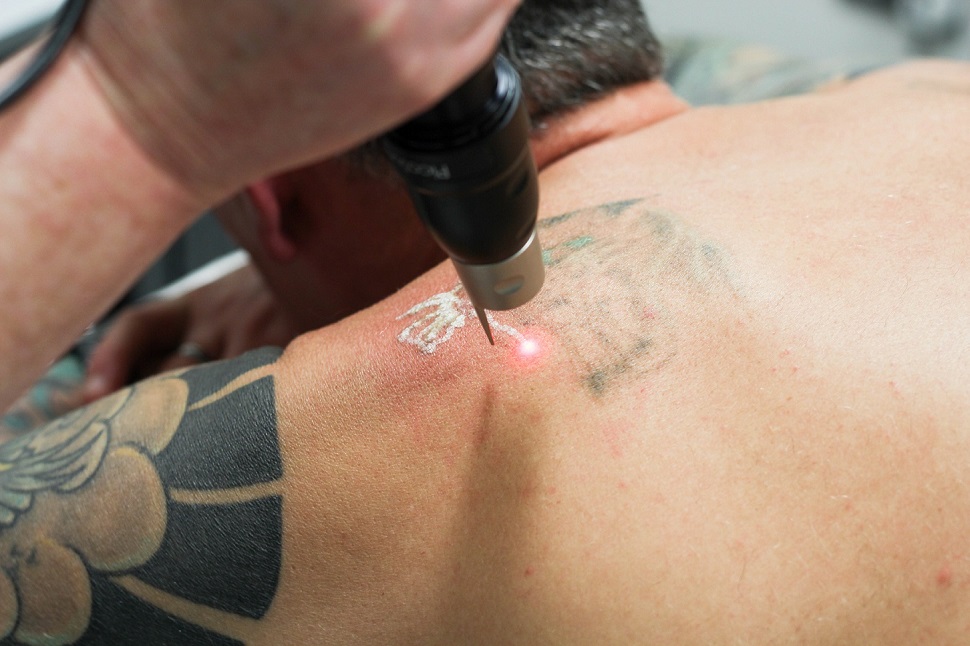
Frosting caused by the the laser treatment. This is a very temporary effect. The frosting disappears on its own accord within an hour after the treatment. This is a normal skin reaction to the skin burn caused by the laser.
Frosting is a normal immediate reaction during tattoo laser fading treatments. The tattooed skin will naturally turn into frosty white colour. This is caused by the carbon dioxide being released as a result of laser burn which surfaces on the upper layer of the skin and usually subsides only after half an hour. The frosting is usually caused by higher frequencies that produce a superficial ablation of the skin. This is not normally caused by very low frequencies used in deep laser sin tightening (i.e. Fraxel laser treatments operating at over 10,000 nm). The frosting effect is also experienced during cryotherapy. Other tattoo fading treatments do not cause frosting.
Minor bleeding is a normal reaction to most professional tattoo fading treatments. In particular Laser, Plasma, surgical excision, Microdermabrasion and IPL. The bleeding is caused by the breakage of the small superficial capillaries in the dermis during the aesthetic treatment. Bleeding during the most popular tattoo fading treatments is minor and lasts only a few minutes. This occurs because any tattoo fading treatment in order to be effective has to include the ablation of the dermis. However in vast majority of cases bleeding is very unlikely to be severe and subsides only after a few minutes.
After the use of ablative treatments (i.e. laser, plasma, IPL), the area may turn red and become only slightly swollen a few moments and minutes after the treatment. Also this is the normal physiological immediate reaction to the skin burn caused by the particular tattoo fading treatment. The reddening and minor swelling only last a few hours and will subside on its own accord being replaced by the blistering (in case of laser treatment and IPL). This reaction is not a usually experienced using other types of tattoo fading treatments.
Certain fading treatments like Laser, Plasma, IPL rely on burning the tattoo in order to help fade it. Blistering is a physiological reaction to any type of burns therefore any treatments which cause an intentional burn of the skin will lead to some form of blistering. The blisters usually start forming the day following the treatment replacing the minor swelling and redness caused by the skin burn. Blistering does not require any treatment and will subside on its own accord. In order to reduce the blistering and the downtime associated with the burn caused by the treatment, ice packing and appropriate soothing products can be used to alleviate the adverse effects immediately after the tattoo fading treatment. Ice Packing and other soothing products should not be used after Plasma tattoo attenuation treatments. This is because the blistering experiences is not major after using Plasma.
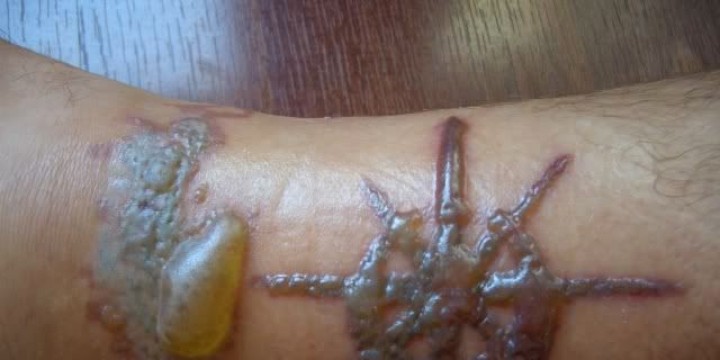
Blisters after laser tattoo fading treatment. This is a physiological reaction to several laser skin treatments.The blisters must not be purposely burst.
Therefore blistering is a normal reaction and an indication that the healing process has begun. They might not look too pretty and could be tender to touch, but blisters should take between 3-14 days to heal up completely. Blisters must not be burst. Purposely bursting the blisters can interfere with the physiological healing process including increasing the likelihood of infections and consequently permanent scarring.
Yet another sign that the tattoo removal is working and healing is taking place. Scabbing is a typical part of the healing process after certain types of tattoo fading procedures. The scabbing process starts to develop two to three days after tattoo fading procedures using plasma (voltaic arcing), osmosis and micro dermabrasion. Scabs often contain fragmented ink particles. When the scabs fall off, the top layer of the ink will come off with it. Picking at or peeling off scabs can increase the risk of scarring, so however tempting it must be avoided. A lot will depend on the size, type, intensity of the treatment and location of the tattoo, however most scabs will fall off on their own accord within two weeks, provided there is no inflammatory infection under-way.
This should be seen as a good sign, as the immune system kicks in and starts to heal the affected area, also this is a sign that there is no ongoing infection. An itching sensation is common, but just like any other type of skin irritation, the client must not scratch the treated area. Scratching could impact on the effectiveness of removal and more importantly break the skin and cause a wound, which could increase the likelihood of infection and scarring. Generally, the client should not apply creams or lotions on the treated area. However in case the itching becomes unbearable the client should seek medical advice.
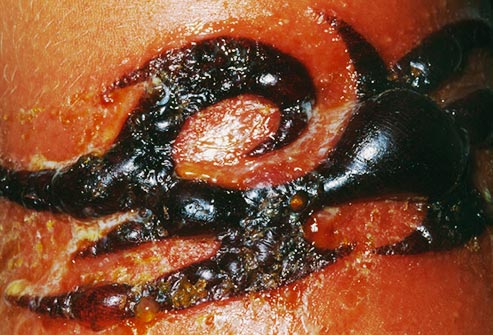
Inflammatory infections can be contracted during the healing process. This can happen after any type of tattoo fading treatment. Infections can also cause some degree of swelling.
Our body’s natural defence system will react to things like illness or infection in a number of different ways. But while swelling usually occurs after being bitten by an insect or other inflammatory causes, it can also happen after undergoing tattoo fading treatments especially due to infections. Inflammatory infections can be easily contracted during the healing process due to the fact that the area is an open wound and like any other wound is exposed to several types of bacteria which cause infections.
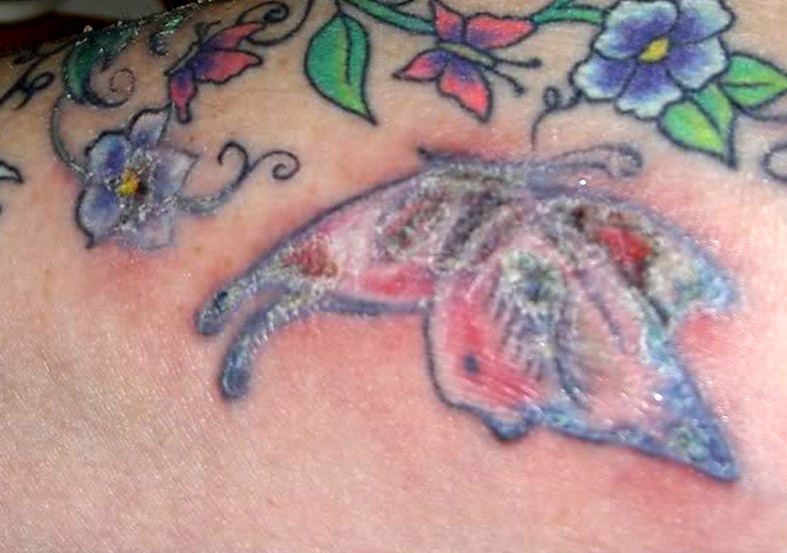
Tattoo infections can manifest in several ways. Sometimes redness is a sign of the onset of an infection. Inflammatory infections are the primary cause of permanent scarring, permanent change in skin texture and other permanent adverse reactions.
Inflammatory infections are the main cause of permanent adverse reactions like scarring and permanent change in skin texture. After laser tattoo removal it is very important not to burst the blisters (which form a couple of days after the treatment) because this causes an open wound and puts the client at an increased exposure to infections. Usually the risks of inflammatory infections diminish as soon as the scabs begin to form. The risks of infections can be minimised but never completely avoided. The bast way to minimise the likelihood of contracting an inflammatory infection during the healing process it to keep the area clean and use the appropriate antiseptic products at regular intervals.
Semi permanent adverse reactions.
The most common semi permanent adverse reactions is a temporary change in skin texture. This is a normal reaction to the skin regeneration process of skin resurfacing treatments. As it is well known, after skin resurfacing treatments the new skin has a pinkish colour and a slight different texture to the rest of the skin. The pinkish colour is due to the lack of pigmentation of the new skin. Over time the skin texture blends in with the rest of the skin and new pigments will form. This applies to all the tattoo fading techniques discussed in this web page including laser tattoo fading.
In other cases, in particular, with the use of Osmosis the common semi-permanent adverse reaction in those cases, especially where an infection has taken place, is a often temporary raised scar. This temporary raised scar usually lasts two to three months and in most cases this will subside over time and the area will blend with the surrounding skin.
The types of permanent adverse reactions can be: Scarring (or permanent change in skin texture), Keloidal formations, hyper-pigmentation and hypo-pigmentation (adverse reaction associate with laser treatments). These types of permanent adverse effects can occur despite the type of tattoo fading treatment carried out. In any case the likelihood of these inherent adverse effects can be minimised but never completely eliminated.
Scarring
Permanent scarring is an inherent risk of any type of tattoo fading treatments, it can be minimised but never completely excluded. Rarely permanent scarring occurs due to the tattoo fading treatment alone. Permanent scarring is often caused by the damage inflicted by the infections contracted during the healing stage. Also in case of laser tattoo fading treatments the normal blisters must not be purposely burst as this also can increase the likelihood of complications especially infections. If the tattoo fading treatment lead to scabbing, the scabs must not be picked and must fall off on their own. If scarring does occur, it is not usually very noticeable and can be minimised with Vitamin E oil or over the counter silicone patches.
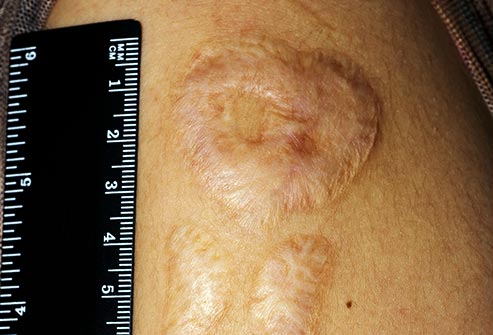
The inherent risks of developing permanent change in skin texture or scarring, can be minimised but never eliminated due to the very nature of the tattoo fading treatments currently available. Risks of scarring are dramatically increased if an infection is contracted during the healing process.
The risks of permanent scarring can never be completely eliminated, even if the tattoo fading procedure is carried out appropriately and the client follows the after-care instructions rigorously. This is because certain individuals are particularly prone to to developing some sort of scarring or permanent difference in skin texture. This is one of the reasons to carry out a patch test at consultation stage. Also some individuals may be prone to developing keloids and some may not even be aware of this predisposition.
Any tattoo fading treatment relies on a form of skin resurfacing, that may be done by means of burning the skin using lasers, electrical arcing, chemical peels etc. Whenever the skin is starting its physiological regeneration process and it is exposed to UV light sources, both natural or artificial, the normal skin reaction can be a hyper-pigmentation. This type of hyper-pigmentation is possible, not only following tattoo fading treatments but also, after any other type of skin resurfacing including cosmetic peels. Therefore cosmetic tattoos and permanent make-up may darken following tattoo fading treatments. Although further resurfacing treatments can fade the hyper-pigmentation away, hyper-pigmentation can be very challenging to resolve at times.

Hyper-pigmentation is an adverse reaction possible following any type of tattoo fading treatment. The likelihood of this occurrence increases if the person exposes the treated area to UV sources and sunlight in general.
Hyper-pigmentation unfortunately is an inherent risk of any type of skin resurfacing treatment, therefore it can be minimised but never completely ruled out after tattoo fading treatments. The best way to minimise the likelihood of hyper-pigmentation is to avoid sun exposure including any source of UV light. The use of total sunscreen up to two months after the healing process should be mandatory. Please note that sun and UV light exposure must be avoided even while using total sun screen up to two months after the last treatment.
Hypo-pigmentation is a common adverse reaction to aesthetic laser treatments in general (including skin tightening, skin resurfacing etc) . This the potential risks of this permanent change in texture and colour can be minimised but never excluded after laser aesthetic treatments. Hypo-pigmentation is particularly common in darker skin tones (six, five and four) however it has been reported on lighter skin types (including one and two). This type of adverse reaction is prevalent only after tattoo laser fading treatments and they are very rare after other types of tattoo fading treatments.
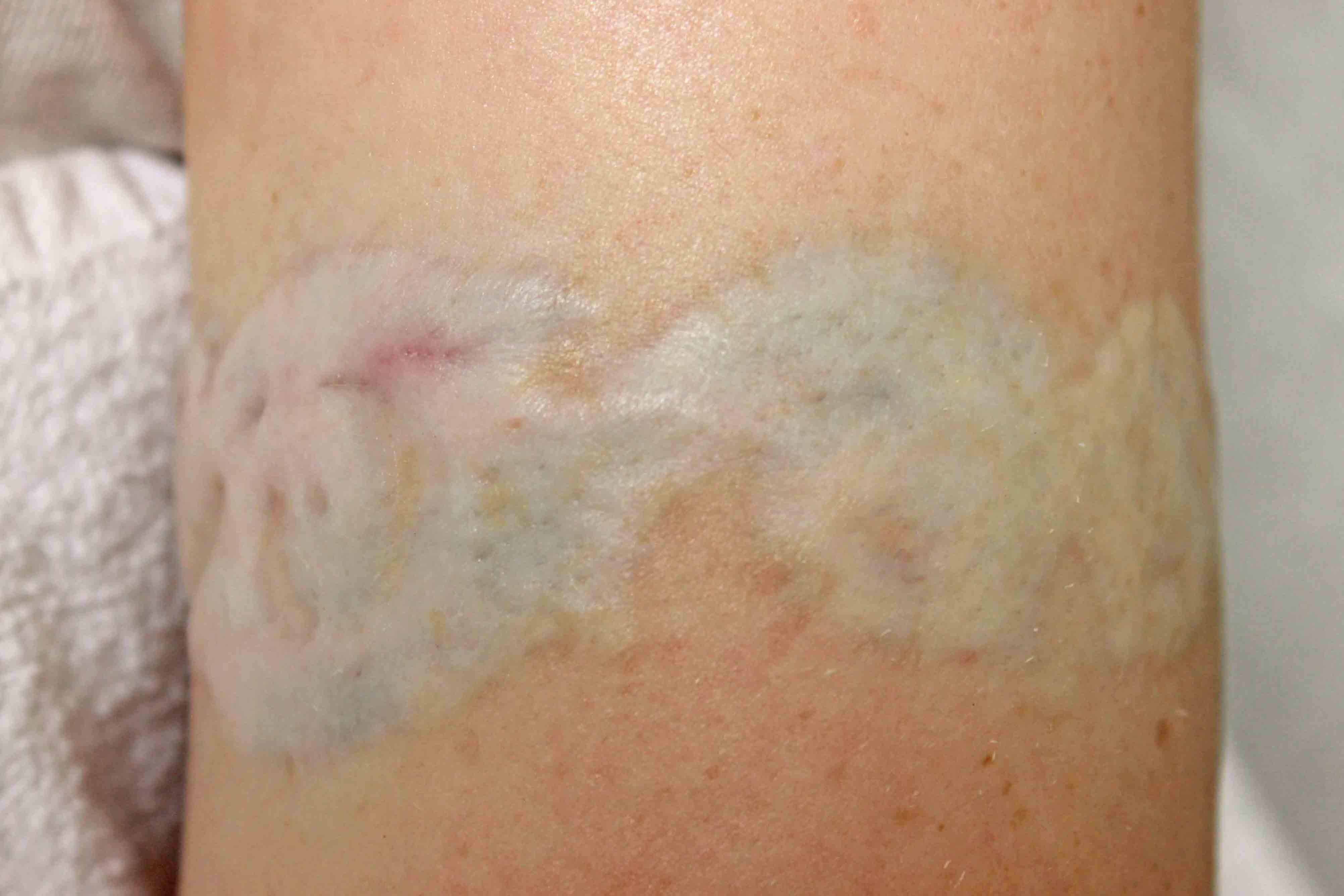
Hypo-pigmentation after laser tattoo removal. Hypo-pigmentation is a particular common adverse reaction to Laser aesthetic treatments in general. They are particularly common on the darker skin types (five and six) however they have also been been reported on lighter skin types (including one and two).
Hyper-pigmentation is where over production of pigmentation occurs during the healing process, conversely hypo-pigmentation is where the skin’s normal pigmentation has been removed and new melanin cannot either permanently or temporarily be produced. Hence the hypo-pigmentation effect can be permanent or semi-permanent. It can sometimes take months or even years for your skin’s pigment to appear normal again. For some people, the skin texture may never be the same.
As a result of hypo-pigmentation, lighter patches of skin will be visible where the tattoo once was and on the area of the skin was treated by the laser. However, both hyper-pigmentation and hypo-pigmentation are bound to be more tolerable than the unwanted tattoo.
Most of the tattoo fading treatments are currently marketed as tattoo removal treatments. To date, the only procedure which can be correctly addressed as tattoo removal is Surgical Excision. Only tattoo surgical excision can guarantee the complete removal within one sessions only, the other techniques can fade the tattoo, however complete disappearance within one session cannot be guaranteed. In the vast majority of cases several sessions are required in order to achieve a satisfactory tattoo fading. Sometimes, the complete seamless (scar-free) removal of tattoos is not always possible using any conventional tattoo fading techniques currently available. In these case tattoo cover-up may be a good option after fading the tattoo as much as possible using most tattoo fading technique available.
Clients are keen to have an estimation of the number of treatments required to achieve their desired results. The number of sessions required can vary from as few as one in case of permanent make-up removal and can even require up to 10 or more sessions in case of resilient tattoos. The number of sessions required also depends the type of tattoo fading treatment as well as the intensity of the treatment. In order to make a realistic estimation, a patch test should be carried out to extrapolate this information from the degree of tattoo fading accomplished after the patch testing. Patch testing also reveals if the client can be susceptible to any particular type of inherent permanent adverse reactions to the particular tattoo fading procedure.
Although laser tattoo fading currently is the most popular "tattoo removal" procedure, there are also several other effective tattoo fading treatments available (i.e. Plasma, Plasma and Osmosis, Osmosis associated with other dermabasion treatments, microdermabrasion, IPL, Chemical peels, Croytherapy etc). Despite the method used to fade the tattoos, in case after a number of tattoo fading sessions, the degree of tattoo fading is only minimal tattoo removal by replacement may be the best option.
[:es]
Aquí proporcionamos una descripción general de los principales tratamientos de eliminación de tatuajes disponibles en la actualidad, la legislación de la UE aplicable y lo que se espera después de este tipo de tratamiento estético.

Los procedimientos que vamos a describir se conocen ampliamente como "eliminación de tatuajes". Esto se debe principalmente a que la "eliminación" completa es el resultado final deseado que los clientes esperan de estos procedimientos estéticos. En realidad, la mayoría de los tatuajes son muy resistentes, y la mayoría de los tratamientos disponibles en la actualidad requieren una serie de tratamientos para lograr resultados satisfactorios siempre que sea posible. Debido a que los procedimientos de eliminación de tatuajes más populares rara vez conducen a la desaparición completa del tatuaje en una sesión, preferiríamos referirnos a la mayoría de los procedimientos de "eliminación de tatuajes" como "desvanecimiento del tatuaje" porque la mayoría de los tratamientos disponibles solo pueden atenuar el tatuaje de manera realista después de cada sesión en lugar de eliminarlo. Como veremos en algunos casos,la eliminación completa no es factible sin dejar algunas cicatrices o algún tipo de modificación permanente de la textura de la piel..

Desvanecimiento leve después de un solo tratamiento con láser suave. Los procedimientos más populares de "Eliminación de tatuajes" solo pueden atenuar el tatuaje un poco después de cada sesión.
La mayoría de los tratamientos populares disponibles actualmente solo pueden atenuar el tatuaje un poco después de cada tratamiento. Por esta razón, la mayoría de los procedimientos anunciados como "eliminación de tatuajes" deben denominarse "desvanecimiento de tatuajes". Actualmente, solo los tratamientos muy invasivos pueden garantizar la eliminación completa en un solo procedimiento o sesión.. Sin embargo, después de hacer esta clara distinción en terminología, podemos referirnos a los procedimientos de "desvanecimiento de tatuajes" como "remoción de tatuajes" para alinearlos con la terminología normal utilizada en el mercado estético actual.
A veces, debido al tipo de pigmentos utilizados, puede ser perjudicial intentar eliminar el tatuaje por completo, ya que hacerlo podría requerir que el cliente se someta a demasiados tratamientos. La exposición prolongada a algunos de los tratamientos más populares para los procedimientos de eliminación de tatuajes (especialmente los tratamientos con láser) puede ser perjudicial para la piel debido a las repetidas quemaduras profundas causadas y, por lo tanto, si no se logran los efectos deseados después de algunas sesiones, puede ser recomendable Descontinuar los tratamientos estéticos. En el caso de que el grado de desvanecimiento del tatuaje sea demasiado bajo, la probabilidad de incurrir en los efectos adversos de estos tratamientos estéticos puede no ser valiosa y, por lo tanto, los tratamientos de desvanecimiento deberían interrumpirse o cambiarse por otros (por ejemplo,. la Escisión del tatuaje o Encubrimiento del tatuaje).
Esta sección se editó por última vez en abril de 2016. Para obtener referencias oficiales, consulte la legislación vigente y los asesores legales profesionales pertinentes.
El dibujo del tatuaje, aunque tiene efectos secundarios potenciales efectos secundarios (incluyendo infecciones) y estos procedimientos involucran la modificación deliberada de la dermis mediante la inyección de los pigmentos en su interior, mientras que causa una herida abierta, los tatuajes hechos para elecciones estéticas y de estilo de vida no se consideran aplicaciones médicas (no para uso médico). usos). Los procedimientos de tatuaje actualmente son realizados por artistas del tatuaje que no están obligados a poseer ninguna calificación médica formal.

Tanto la legislación vigente en Europa como en el Reino Unido en particular no dictan el tipo de calificaciones que el tatuador o el profesional de la eliminación de tatuajes deben tener para realizar este procedimiento. Por lo tanto, en el Reino Unido, prácticamente cualquier persona puede iniciar un negocio de eliminación de tatuajes, independientemente de las calificaciones. Sin embargo, algunas compañías de seguros insistirán en que el profesional de la eliminación de tatuajes tiene un cierto nivel de calificación formal.
En el caso de la eliminación de tatuajes, aunque en la publicidad, varias clínicas se refieren a ellos como "procedimientos médicos" y al cliente también se le conoce como "paciente", desde un simple punto de vista legislativo procedimientos de desvanecimiento de tatuajes (que no implican cirugía, es decir, escisión). ) se consideran procedimientos estéticos. Además, la interpretación actual de la legislación europea considera los procedimientos de desvanecimiento del tatuaje como aplicaciones cosméticas / estéticas. Esto se debe a que la razón principal detrás de un procedimiento de eliminación de tatuajes es el hecho de que el cliente lamenta su tatuaje anterior y desea cambiarlo o eliminarlo por completo. Por supuesto, no hay razones médicas para tener un tatuaje estético dibujado en primer lugar, ni tampoco hay razones médicas más allá de un proceso de eliminación de tatuajes estéticos.
Por estas razones, en Europa, cualquier procedimiento de eliminación de tatuajes se considera un mero procedimiento estético. Desde principios de la década de 2000, ha habido varias presiones de cabildeo para modificar la clasificación de estado legal de los procedimientos de desvanecimiento de tatuajes (remoción de tatuajes) en general, a fin de ser considerados como aplicaciones médicas (usos médicos). Como sabemos, casi todos los procesos de eliminación de tatuajes requieren infligir una quemadura o una lesión intencional del área tatuada de alguna manera para desvanecer o eliminar los pigmentos que residen dentro de la dermis.. En el caso de técnicas de desvanecimiento de tatuajes, esto se realiza varias veces para lograr los efectos deseados. Tanto los salones de tatuajes como las clínicas que realizan retiros de tatuajes deben cumplir con las legislaciones locales, que pueden variar de un país a otro y de una región a otra en cada país europeo.
Por lo tanto, como hemos visto, los procedimientos de eliminación de tatuajes se consideran tratamientos no médicos por esta razón, por lo general no están cubiertos por las pólizas de seguro de salud estándar y tampoco son proporcionados de forma gratuita por el NHS.
Los tatuajes son mucho más fáciles de dibujar que de ser eliminados. Esto se debe a que los pigmentos de los tatuajes permanentes están hechos de tal manera que resistirán la prueba del tiempo. Sin embargo, la reacción natural del cuerpo a los pigmentos de los tatuajes es intentar eliminarlos, esta absorción de pigmentación fisiológica normal es normal y se lleva a cabo muy lentamente. En otras palabras, aunque todos los tatuajes permanentes se desvanecen con el tiempo, su velocidad de desvanecimiento es tan lenta que efectivamente pueden considerarse permanentes.

Los tatuajes son muy resistentes a la prueba del tiempo porque están destinados a ser permanentes, sin embargo, se desvanecen ligeramente con el tiempo por su propia voluntad.
La velocidad a la que el tatuaje se desvanece con el tiempo depende de una serie de factores y uno de ellos es el tipo de pigmentos utilizados por el artista del tatuaje. Diferentes tipos de pigmentos se desvanecerán a diferentes velocidades y de diferentes maneras. También la exposición al sol y el bronceado pueden aumentar la tasa de desvanecimiento fisiológico. Esto se debe a que el amplio espectro de la luz solar también incluye una pequeña proporción de luz infrarroja que penetra en la piel y destruye los pigmentos del tatuaje..

El sistema inmunológico del cuerpo ataca los pigmentos y los destruye, pero este proceso es muy lento. La decoloración a lo largo del tiempo también depende del tipo de pigmentación utilizada. Hay pigmentos más y menos resistentes. En esta imagen podemos apreciar cómo el dibujo se difuminó con el tiempo a medida que los bordes perdían su nitidez con el tiempo. Este tipo de desenfoque también se puede experimentar después de los procedimientos de desvanecimiento del tatuaje. Los procedimientos de desvanecimiento del tatuaje se utilizan para acelerar el proceso natural de desvanecimiento del tatuaje, que de otro modo sería demasiado lento.
En la figura de arriba podemos apreciar el deterioro de un tatuaje con el tiempo. A veces, este desvanecimiento natural del tatuaje se acelera con la exposición repetida a la luz solar (es decir, el bronceado repetido). Es bien sabido que el bronceado intenso y repetido tiene efectos perjudiciales en el brillo de los tatuajes estéticos a lo largo del tiempo. Esto se debe a que algunas longitudes de onda más bajas de la luz solar natural de amplio espectro (en particular el rojo y el infrarrojo) tienen el efecto de descomponer los pigmentos de los tatuajes, de manera similar a los láseres y la IPL. Sin embargo, el proceso es mucho más lento que el grado de desvanecimiento alcanzado con los tratamientos con Láser o IPL De hecho, lo que estamos haciendo con las técnicas de "desvanecimiento del tatuaje" es acelerar este proceso natural de desvanecimiento del tatuaje de una u otra manera.
Porque los pigmentos de los tatuajes están destinados a ser permanentes y residen dentro de la dermis, los procedimientos de eliminación de tatuajes implican normalmente un grado de tratamiento dérmico. Debido a esto, el procedimiento de "eliminación de tatuajes" o, más adecuadamente, de "desvanecimiento de tatuajes" no puede estar libre de riesgos inherentes.
Debido al hecho de que los tatuajes son para ser permanentes y resistentes con el tiempo, generalmente serán mucho más difíciles de eliminar que de haberlos hecho. Una sesión suele ser suficiente para dibujar un hermoso tatuaje de tamaño mediano, sin embargo, desvaneciéndolo o incluso retirarlo por completo puede ser muy difícil y, a veces, no vale la pena debido a las complicaciones que conlleva la eliminación completa de tatuajes resistentes particulares.
Una de las preguntas más frecuentes que hacen los clientes es la cantidad de sesiones de desvanecimiento de tatuajes que se requieren para lograr el resultado deseado (que es la eliminación completa sin problemas). Es importante administrar sus expectativas porque en muchos casos esperan una eliminación completa sin dejar rastro en una o muy pocas sesiones solamente. En la mayoría de los casos, no se conocen actualmente técnicas de desvanecimiento que garanticen una eliminación completa sin dejar rastro.
Además, no todos los tatuajes presentan la misma resistencia al tratar de atenuarlos. Algunos tipos de tatuajes pueden eliminarse fácilmente en tan solo unas pocas sesiones fáciles de desvanecimiento, mientras que otros pueden ser mucho más difíciles y, a veces, casi imposibles de eliminar por completo sin dejar una cicatriz, o algún tipo de rastro (es decir, hipopigmentación permanente en caso de extracción con láser) ) debido a la agresividad del tratamiento requerido para su eliminación completa. La cantidad de desvanecimiento del tatuaje que se desea se puede lograr de dos maneras, ya sea a través de un número relativamente alto de tratamientos de desvanecimiento del tatuaje suave o mediante algunas sesiones de tratamiento de alta intensidad. En general, cuanto mejor sea la calidad del pigmento usado y mejores los dispositivos utilizados para dibujar los tatuajes (logrando una distribución superficial de pigmento superficial en la capa dérmica), ) más fácil será lograr los resultados deseados y minimizar la agresividad o la intensidad de los tratamientos de desvanecimiento del tatuaje.
Por otro lado, los pigmentos de baja calidad o incluso los colores "no aptos para el propósito" pueden ser casi imposibles de eliminar por completo con las técnicas de eliminación de tatuajes más populares. En algunos casos, la única opción viable para la eliminación de tatuajes mal dibujados (con pigmentos "no aptos para el propósito") puede ser la extirpación quirúrgica del tatuaje.. También a veces los pigmentos de los tatuajes pueden inyectarse más en la dermis más cerca de la hipo-dermis, lo que puede dificultar aún más la eliminación.

La "eliminación de tatuajes" con láser es solo una de las varias opciones disponibles para la eliminación de tatuajes. Aunque es la opción más popular, no todos los tatuajes se desvanecerán de la misma manera. Tenga en cuenta que cuanto más profundo sea el posicionamiento de los pigmentos dentro de la dermis, más desafiante será el desvanecimiento del tatuaje (consulte la sección sobre fisiología del tatuaje para obtener más información) .
Tenga en cuenta que los puntos a continuación se aplican principalmente a los procedimientos de desvanecimiento de tatuajes más comunes y, a menos que se indique lo contrario, no se refieren a la escisión quirúrgica del tatuaje.. En general, la facilidad para eliminar tatuajes depende de los siguientes factores principales:
- Profundidad de los pigmentos. Cuanto más profundos sean los pigmentos dentro de la dermis, más difícil será desvanecer el tatuaje. Esto se aplica a cualquier técnica de desvanecimiento del tatuaje. Además, a veces los pigmentos de los tatuajes podrían haber sido inyectados de manera particularmente profunda e incluso podrían estar localizados dentro o cerca de la hipo-dermis. En estos casos, puede ser poco realista esperar la eliminación completa del tatuaje sin dejar ningún rastro.
- Tipo de pigmentos. La composición química determina la facilidad de eliminación. Además, cuanto mejor sea la calidad de los pigmentos del tatuaje, más fácil será desvanecerlos.
- Color de los pigmentos (solo tatuajes con láser). Ciertas longitudes de onda solo pueden atenuar ciertos colores. Cuanto más brillantes sean los colores de los tatuajes, más desafiantes serán para desvanecerse. A la inversa, cuanto más oscuro sea el tatuaje, más fácil será desvanecerlo. La longitud de onda utilizada por el láser determinará el color que se desvanece y el número de sesiones necesarias. Otros tratamientos de desvanecimiento de tatuajes son ciegos al color (desvanecen todos los colores indiscriminadamente). La mayoría de las otras opciones de atenuación de tatuajes son ciegas al color (desvanecen todos los colores indiscriminadamente).
- Tipo de tatuaje. Un tatuaje dibujado no profesional suele ser más difícil de desvanecer que los tatuajes profesionales. Esto se debe a que la profundidad de la distribución de los pigmentos puede no ser uniforme en todo el tatuaje. Por lo tanto, el tatuaje puede desvanecerse de diferentes maneras dependiendo de la profundidad de los pigmentos.
- Densidad y cantidad de los pigmentos del tatuaje. Cuanto más densa es la tinta, más capas de pigmentos hay en el tatuaje y más tiempo tardará en desaparecer el tatuaje. Lo que importa es cuánta tinta hay en la piel. Por ejemplo, los tatuajes de encubrimiento tienen dos capas de pigmentación, por lo tanto, serán más difíciles de desvanecer que los tatuajes normales.
- Zona cubierta por el tatuaje.. Cuanto más ancho sea el tatuaje, más sesiones de desvanecimiento se requerirán para lograr los resultados deseados. Los tatuajes grandes no pueden tratarse en su totalidad porque los riesgos asociados con el tratamiento y los efectos adversos serían demasiado altos. En caso de tatuajes, los tratamientos que se basan en quemar la piel (láser, plasma eléctrico, peelings químicos, etc.). Exponer el cuerpo a quemaduras extensas puede ser perjudicial para el individuo. Esto se debe a que los riesgos potenciales y la probabilidad de una reacción adversa pueden aumentar dramáticamente proporcionalmente con el área cubierta dentro de la sesión. Además, otros tratamientos de desvanecimiento de tatuajes, que utilizan otros principios de rejuvenecimiento de la piel, no deben usarse en áreas extensas dentro de un tratamiento, ya que esto puede aumentar la probabilidad de sus reacciones adversas asociadas. Generalmente, en el caso de tatuajes grandes, se tratarán en secciones más pequeñas para manejar los riesgos de los efectos adversos asociados. En el caso de la extirpación quirúrgica de tatuajes grandes, puede ser necesario un injerto de piel para reemplazar el área grande de la piel perdida.
- Posición del tatuaje en el cuerpo. Algunas áreas no son adecuadas para ciertos tipos de tratamientos de desvanecimiento de tatuajes, por lo que su eliminación puede ser muy difícil. Estas son áreas sujetas a flexión y estiramiento (por ejemplo, rodillas, codos, axilas, etc.). Además, esas áreas estarán inevitablemente expuestas al roce constante de la ropa (por ejemplo, la línea de la cintura).
- Tono de la piel (solo tatuajes con láser). Uno de los efectos secundarios propios de los tratamientos de desvanecimiento de tatuajes con láser es la posibilidad de causa hipopigmentación. Este es un efecto secundario que generalmente no ocurre después de otros tipos de tratamientos de desvanecimiento de tatuajes. En general, cuanto mayor es la intensidad del tratamiento, mayor es la probabilidad de causar hipopigmentación. A la inversa, cuanto menor sea la intensidad del tratamiento con láser, menor será la probabilidad de hipopigmentación. Cuanto más oscuro es el tono de la piel, mayor es la probabilidad de hipopigmentación. Por lo tanto, cuando se trata de tatuajes en tonos oscuros de la piel, la intensidad del tratamiento debe reducirse (para reducir la probabilidad de hipopigmentación), lo que aumenta el número de sesiones requeridas para lograr un nivel satisfactorio de desvanecimiento del tatuaje.
- Edad del tatuaje (solo tatuajes con láser). Cuanto más viejo sea el tatuaje, más desafiante puede ser desvanecer los pigmentos. Por el contrario, cuanto más fresco sea el tatuaje, más fácil será desvanecerse. Esto se aplica a la eliminación de tatuajes con láser, la mayoría de las otras técnicas de decoloración tienden a desvanecer todos los tatuajes de la misma manera, a pesar de su edad.
- Intensidad del tratamiento. . La intensidad del tratamiento del tipo particular de tratamiento de desvanecimiento del tatuaje determina también la cantidad de desvanecimiento de la pigmentación después de cada sesión. En general, cuanto mayor es la intensidad, más se desvanece el tatuaje después de cada tratamiento. Por el contrario, cuanto más suave sea el tratamiento, menor será el grado de desvanecimiento del tatuaje después del tratamiento.
Estimar la cantidad de sesiones requeridas para lograr los resultados finales deseados es a menudo difícil si se basa la opinión en los factores clave (arriba). Esto se debe a que rara vez hay información confiable acerca de la forma en que se dibujó originalmente el tatuaje, lo que determina la facilidad de desvanecimiento de cada tatuaje en particular. A menudo, algunas suposiciones o información sobre el tatuaje pueden resultar incorrectas. En otras palabras, el profesional de remoción de tatuajes no puede establecer la reacción del tatuaje específico al tratamiento de desvanecimiento solo mirando el tatuaje o haciendo preguntas sobre cómo se dibujó el tatuaje (rara vez hay información confiable sobre la pigmentación). Profundidad de distribución, de la composición química de la tinta utilizada etc).
Por lo tanto, la mejor opción para estimar el número de sesiones requeridas para lograr los resultados deseados es realizar una extrapolación basada en el grado de desvanecimiento del tatuaje después de la prueba de parche inicial.. A partir de esta información, el profesional de la belleza puede proporcionar una estimación más confiable del número de sesiones requeridas para lograr los resultados deseados.
Sin embargo, incluso una estimación basada en el grado de desvanecimiento logrado después de la prueba de parche del tatuaje puede no ser muy precisa. Cuánto se desvanece el tatuaje después de cada tratamiento varía de un tratamiento a otro. El tatuaje se desvanece más después de los primeros tratamientos, esto se debe a que los pigmentos superficiales son los que se eliminan más fácilmente. Se logra un desvanecimiento relativamente alto eliminando los pigmentos más superficiales. Por lo tanto, los pigmentos que quedan después del tratamiento de desvanecimiento del tatuaje anterior son más resistentes y están ubicados más adentro de la dermis.
Por lo tanto, en ciertos casos en los que los pigmentos que quedan después de una serie de tratamientos de desvanecimiento del tatuaje son muy resistentes y / o están ubicados muy dentro de la dermis, la cantidad de desvanecimiento del tatuaje será menor después de los tratamientos iniciales de desvanecimiento del tatuaje. Esto se debe a que a medida que el tatuaje se desvanece, generalmente los pigmentos restantes son los que son los más difíciles de eliminar. En ciertos casos de pigmentación resiliente particular, eliminar el desgaste del tatuaje puede llegar a ser tan arduo que los intentos adicionales de desvanecimiento no solo pueden volverse inútiles sino también potencialmente contraproducentes, ya que solo exponen al cliente a los efectos adversos del procedimiento de desvanecimiento del tatuaje sin traer mejoras sustanciales. En este caso, los pasos adicionales pueden ser la extirpación quirúrgica o el encubrimiento del tatuaje.
Todas las opciones de eliminación de tatuajes conllevan reacciones adversas potenciales y cualquier riesgo asociado con estos procedimientos estéticos se puede minimizar, sin embargo, no se puede descartar por completo, incluso siguiendo los procedimientos correctos y los protocolos de cuidado posterior. Como hemos visto,los tatuajes también presentan riesgos inherentes, ,sin embargo, la probabilidad percibida de reacciones adversas asociadas a su eliminación generalmente se considera mayor.

Formación queloidal después de la eliminación de tatuajes. Algunas reacciones adversas no pueden ser evitadas. Por eso también es importante realizar una prueba de parche en la etapa de consulta.
La razón de esto es muy simple: aunque los riesgos inherentes tanto del dibujo del tatuaje como de la eliminación del tatuaje son muy similares, la eliminación del tatuaje se percibe como un procedimiento más riesgoso porque, a diferencia del tatuaje, a menudo se requieren varios tratamientos de desvanecimiento del tatuaje para lograr resultados satisfactorios. Por otro lado, el cliente se expone a los riesgos inherentes de tatuarse solo una vez, por el contrario, tendrá que exponerse a los efectos adversos potenciales varias veces para "eliminarlos" (o más bien, desvanecerlos). Debido a esta exposición repetida a los efectos adversos inherentes de los tratamientos de desvanecimiento del tatuaje,, los riesgos asociados percibidos son mayores en la eliminación de tatuajes que el proceso de tatuaje. Los riesgos asociados con cada tratamiento de eliminación de tatuajes o de desvanecimiento varían dramáticamente según el tipo de tratamientos de desvanecimiento, la forma en que se realizó el tratamiento (por ejemplo, la intensidad del tratamiento) y especialmente el tratamiento posterior. Por lo tanto, el cliente debe someterse a varias quemaduras o varios tratamientos de renovación cada vez que se exponga a efectos secundarios similares a los del proceso de dibujo del tatuaje. Es importante enfatizar que la mayoría de las reacciones adversas permanentesa las técnicas de desvanecimiento de tatuajes más populares generalmente se deben a que el cliente no cumple con los procedimientos de cuidado posterior.
Para revisar los efectos indeseables o reacciones adversas al tatuaje por favor Haga Cluck aquí.
Actualmente, la solicitud de eliminación de tatuajes está en constante aumento y los precios cobrados por este tipo de procedimiento estético también son altos debido a la relativa complejidad de los procedimientos de eliminación de tatuajes. Además, cada vez más personas están muy motivadas y, a veces, están dispuestas a pagar casi cualquier cantidad para que se les quite el tatuaje.
En el Reino Unido, no es raro que algunas citas de eliminación de tatuajes alcancen las 20 o 30 mil libras. Además, debido a la complejidad inherente de estos tratamientos estéticos, el mercado de eliminación de tatuajes proporciona información muy conflictiva en relación con cada tipo de procedimiento de "desvanecimiento del tatuaje" o "eliminación del tatuaje". Se cree que esto se debe a los diversos intereses financieros creados en los procedimientos de "eliminación de tatuajes". Algunas fuentes señalan que algunos tipos de tratamientos son extremadamente riesgosos y se enfocan solo en sus posibles reacciones adversas del tipo específico de tratamiento de desvanecimiento del tatuaje. Otras fuentes enfatizan los riesgos de someterse a procedimientos de remoción de tatuajes por parte de practicantes de láser "no calificados" para remoción de tatuajes al señalar y mostrar solo los efectos adversos potenciales de los procedimientos de desvanecimiento de tatuajes. Sin embargo, como es bien sabido, ninguna técnica de desvanecimiento del tatuaje puede tener efectos adversos que puedan minimizarse pero nunca eliminarse por completo. Debido a estos dos factores (intereses financieros creados y el mero hecho de que ninguna de las opciones de desvanecimiento de tatuajes disponibles en la actualidad no pueden considerarse completamente libres de riesgos), hay varios datos contrastantes en el dominio público que sugieren que un método es más efectivo o más seguro que otros.
Hay varias opciones para la eliminación de tatuajes. En este sitio web exploraremos los más populares primero. Algunos de los tratamientos de desvanecimiento de tatuajes más comunes involucran esencialmente técnicas de rejuvenecimiento de la piel (láser, arcos de plasma / eléctricos, microdermabrasión, exfoliaciones cosméticas, etc.). Estas técnicas, aunque a veces son lentas, conducirán a un cierto grado de desvanecimiento de los tatuajes, sin embargo, el problema con el rejuvenecimiento de la piel en la eliminación de tatuajes es que los pigmentos del tatuaje se encuentran dentro de la dermis por lo que el tratamiento de rejuvenecimiento debe involucrar a la capa dérmica para que sea algo eficaz. Cualquier rejuvenecimiento de la piel que involucre la capa dérmica tiene efectos adversos intrínsecos potenciales que incluyen cicatrización. El tipo de rejuvenecimiento de la piel determina los tipos y la prevalencia de los posibles efectos adversos.
Esta es una de las opciones más populares disponibles en el mercado. Esto se anuncia mucho en todo el mundo y se utiliza en varias clínicas de cosmética. Este método se basa en la renovación cutánea de la capa dérmica (causando una quemadura controlada). Esencialmente, los pigmentos de los tatuajes, así como la capa dérmica, son atacados por el láser, lo que hace que parte de los pigmentos sean reabsorbidos. Para obtener más información acerca de la eliminación de tatuajes con láser o el desvanecimiento de tatuajes con láser haga click aquí.
Esta es una técnica que se ha utilizado durante varios años, especialmente en Italia y Alemania, y se ha utilizado durante muchos años en muchas clínicas estéticas europeas con muy buenos resultados consistentes. Combina el uso de salación y termabrasión. La termabrasión puede llevarse a cabo utilizando dispositivos que generen arcos eléctricos o ciertos dispositivos de radiofrecuencia que tienen el mismo efecto ablativo (quemado). Los dispositivos para este propósito previsto han estado en el mercado durante los últimos 40 años. Hoy en día hay incluso varios dispositivos más en el mercado y esta técnica está aumentando en popularidad en toda Europa. Aunque es muy efectiva, esta técnica de desvanecimiento del tatuaje no es tan popular como la remoción de tatuajes con láser (desvanecimiento). Si se realiza adecuadamente, este tratamiento de desvanecimiento del tatuaje generalmente logra un mayor grado de desvanecimiento de la pigmentación que la mayoría de las otras técnicas. Para obtener más información sobre este tipo de procedimiento, haga click aquí (el enlace se actualizará más adelante, antes del 20 de septiembre de 2016).
En el siguiente video podemos ver una parte del procedimiento quirúrgico para la extirpación del tatuaje. El practicante se quita el tatuaje con un bisturí y cierra la herida con puntos de sutura.
La extirpación quirúrgica, también conocida como "eliminación quirúrgica de tatuajes", es una de las opciones más invasivas para la "eliminación de tatuajes" en comparación con los procedimientos de "desvanecimiento" de tatuajes más populares. Sin embargo, este es el único procedimiento al que se puede hacer referencia efectivamente como "eliminación de tatuajes". Esto se debe a que solo la "eliminación quirúrgica de tatuajes" puede garantizar la eliminación completa de los tatuajes no deseados en una sesión. Todos los demás tratamientos estéticos no quirúrgicos son en su mayoría menos invasivos, sin embargo, solo pueden desvanecer el tatuaje, pero rara vez se eliminan por completo en una sesión.

Ejemplo de tatuaje de escisión quirúrgica. Como podemos ver, el tatuaje no se encuentra en un área especialmente propensa al estiramiento y la flexión. En este caso particular, el tatuaje, aunque relativamente grande para una escisión, se coloca en la parte superior del brazo donde generalmente hay una cierta cantidad de piel suelta que se puede eliminar, sin causar efectos indeseables de "tirar la piel". Podemos apreciar la típica cicatriz característica de una escisión quirúrgica.
Antes de sugerir la "extirpación quirúrgica del tatuaje", el médico evalúa el área para tener una idea clara de cómo se vería la parte si la piel donde reside el tatuaje se eliminara por completo. Si los "efectos de tracción" de la cirugía no son dramáticos o no perjudicarían los movimientos normales (por lo tanto, aparte de la cicatriz, el resultado final se verá prácticamente perfecto), entonces el procedimiento se realiza bajo anestesia local. Este es el único procedimiento de eliminación de tatuajes que requiere anestesia local, para todos los otros tratamientos de "desvanecimiento" de tatuajes, los productos adormecedores tópicos suelen ser suficientes para la comodidad del cliente. En algunos casos en los que el tatuaje cubre un área grande, este procedimiento puede no ser recomendable, ya que eliminar una gran parte de la piel podría ser perjudicial y, en ocasiones, requeriría un injerto posterior de la piel.

Los mejores candidatos para este tipo de procedimiento quirúrgico son los tatuajes relativamente pequeños, que no están ubicados en áreas especialmente propensas a la flexión y el estiramiento. El tatuaje en la imagen es relativamente pequeño y no está ubicado en un área crítica del cuerpo. La extirpación quirúrgica de grandes porciones de la piel puede ser perjudicial para el individuo y debe evitarse.
No todos los tatuajes son los mejores candidatos para este tipo de procedimiento. Si están ubicadas en la cara o áreas donde la piel está sujeta a flexión y estiramiento (es decir, codos, rodillas, hombros, etc.), es posible que este procedimiento no sea recomendable. Específicamente, este procedimiento debe evitarse cerca de las articulaciones principales donde se requiere un cierto grado de estiramiento de la piel para el movimiento normal. El principal problema con la eliminación de tatuajes grandes mediante escisión quirúrgica es el hecho de que la piel se "estirará" y los efectos del procedimiento podrían ser claramente visibles mucho después de la eliminación (resultados no perfectos). Una de las desventajas de este tipo de procedimiento es que casi inevitablemente dejará un cierto grado de cicatrización causada por las suturas. Por lo tanto, si el tatuaje está en la cara, la constricción de la piel causada por la cirugía y la cicatriz dejada por las suturas no hacen que este tipo de procedimiento sea el más recomendable. Los tatuajes pequeños son los mejores candidatos para este tipo de procedimiento, especialmente si están ubicados en áreas donde hay una cantidad relativa de piel suelta que se puede eliminar sin necesidad de injertos de piel o la piel se puede extraer sin causar un "tirón" mayor efecto que podría hacer que el área se vea incómoda.
Esta técnica quirúrgica demuestra ser muy efectiva para eliminar ciertos tipos de tatuajes en los que la presencia de una pequeña cicatriz no será muy importante. algunos tatuajes y permite que el cirujano retire las áreas entintadas con gran precisión y en una sola sesión.
Ventajas de la extirpación quirúrgica del tatuaje.
La principal ventaja de la escisión es que el tatuaje desaparecerá inmediatamente después del procedimiento quirúrgico. Esta es generalmente la opción más rentable para tatuajes más pequeños. Este procedimiento, aunque invasivo, ofrece la clara ventaja clínica de evitar las exposiciones múltiples a quemaduras y otros efectos adversos intrínsecos de la mayoría de los procedimientos de desvanecimiento de tatuajes. Debido a que solo se requiere un procedimiento para la eliminación de tatuajes pequeños, el costo de este tipo de procedimiento suele ser más bajo que otros procedimientos de desvanecimiento de tatuajes.
Efectos adversos.
Los efectos secundarios son generalmente menores, pero pueden incluir:
- Se debe esperar cierto grado de cicatrización debido a las suturas y no se puede evitar..
- La infección podría ocurrir si el área no se cuida adecuadamente.
- La piel puede sentirse más apretada por un tiempo después del procedimiento debido a la piel faltante.
- En ciertos casos, cuando se requiere la eliminación de tatuajes grandes con este procedimiento quirúrgico, puede ser necesario realizar un injerto de piel. La eliminación puede no ser perfecta si la piel extraída es relativamente grande (también los costos podrían aumentar dramáticamente).
Costo estimado.
El costo de este tipo de procedimiento es generalmente más bajo que la mayoría de los tratamientos de desvanecimiento de tatuajes. Esto se debe principalmente a que el costo de las técnicas de desvanecimiento del tatuaje es acumulativo y se requieren varios tratamientos para lograr resultados satisfactorios. En el caso de la extirpación quirúrgica del tatuaje de tatuajes pequeños, una sesión será suficiente para eliminar el tatuaje. El costo de la eliminación de tatuajes quirúrgicos depende de varios factores:
- País donde se realiza el trámite. En ciertos países, la amplia disponibilidad de cirujanos puede hacer que este procedimiento sea más rentable que otros tratamientos de desvanecimiento de tatuajes más populares. Los dispositivos de desvanecimiento del tatuaje a veces pueden ser muy costosos, lo que hace que los procedimientos de desvanecimiento del tatuaje, especialmente la "extirpación con láser", sean más costosos que la escisión quirúrgica.
- El tamaño del tatuaje. Cuanto más grande sea el tatuaje, más costoso puede costar el procedimiento debido a la probabilidad de que se requiera un injerto de piel. Como se señaló anteriormente, este procedimiento puede no ser recomendable para la eliminación de tatuajes relativamente grandes.
- El tipo de anestesia utilizada durante el procedimiento. La anestesia local es la opción preferida y más rentable para este tipo de procedimiento. En caso de que el cirujano opte por la anestesia general total, el procedimiento puede ser mucho más costoso. La anestesia general es la opción preferida en el caso de la extirpación quirúrgica del tatuaje que también requiere un injerto de piel. A diferencia del otro procedimiento de desvanecimiento de tatuajes con tatuajes más común, los productos adormecedores tópicos no serán suficientes para los procedimientos quirúrgicos.
Debido a su efectividad, los principios básicos de salabrasion (combinación de ósmosis y abrasión dérmica) se han utilizado durante varios cientos de años y esto lo convierte en una de las formas más antiguas de desvanecimiento de tatuajes que se conocen actualmente. Si bien la eficacia de otros métodos puede estar limitada por la edad del tatuaje, los colores de los pigmentos (en caso de desvanecimiento del tatuaje con láser), el tipo de pigmentos del tatuaje y y sus distribuciones dentro de la dermis,, el Método Salino (Osmosis) puede eliminar ambos. Y nuevos tatuajes independientemente de los pigmentos utilizados. Este método también es efectivo en los tatuajes de grado profesional y en los aficionados y en el maquillaje permanente, sin embargo, no puede desvanecer los pigmentos muy profundos cerca de la hipo-dermis.
Además, dado que el método salino no se basa en la destrucción de las capas de la piel, el riesgo de cicatrización (aunque siempre existe y nunca se puede descartar) es considerablemente menor que en los métodos más tradicionales. Finalmente, el dolor y el tiempo de espera entre tratamientos disminuyen en comparación con los tratamientos con láser.. Cuando la formación de ampollas is a normal inevitable adverse reaction to the burn caused by the Laser, it es una reacción adversa inevitable e normal a la quemadura causada por el láser, no se experimenta después de la reacción. La evidencia de la eficacia de Salación (referida como palabras clave u ósmosis) está corroborada por el hecho de que el grado de desvanecimiento del tatuaje es relativamente predecible y los resultados son repetibles. La eficacia de la ósmosis también está validada por varios trabajos de scientific research papers (ver referencias adicionales)y estudios realizados por fabricantes de dispositivos de radiofrecuencia. Referencia.
Las técnicas y protocolos utilizados con la salación (o ósmosis) han evolucionado a lo largo de los años debido a los diferentes dispositivos de rejuvenecimiento de la piel que se han comercializado con el tiempo o las nuevas técnicas de abrasión de la piel. Además, el hecho de que en Europa y en la mayor parte del mundo la eliminación de tatuajes no seaun procedimiento altamente regulado ha ayudado a desarrollar diferentes protocolos para esta aplicación. La ósmosis (o Salabración) es una técnica de desvanecimiento del tatuaje porque conduce a un grado de desvanecimiento de la pigmentación después de cada tratamiento y no se puede garantizar la eliminación completa dentro de un tratamiento.

El cloruro de sodio (sal) induce la ósmosis y desvanece los colores de los tatuajes de manera muy efectiva (por esta razón, este tipo de procedimiento estético se conoce como "color ciego"). La osmosis debe combinarse con otros tipos de tratamientos de abrasión de la piel para que sea eficaz.
El ingrediente principal de este tipo de técnica de eliminación de tatuajes es el cloruro de sodio (sal). La razón para que este tratamiento sea eficaz es el hecho de que la ósmosis inducida cuando la sal (cloruro de sodio) se coloca sobre los pigmentos del tatuaje, tiene el efecto directo de atraer no solo más moléculas de agua hacia él, sino también los pigmentos del tatuaje que están rotos.

Esta figura ilustra el principio físico general del proceso osmótico. El agua tiende a moverse hacia la solución más salina. Con la ósmosis en la eliminación de tatuajes, el agua se dirige hacia la solución salina altamente concentrada. Esto también permite que los pigmentos de color de tatuaje libres rotos se dirijan hacia la solución salina estéril o la sal fina estéril.
La aplicación de sal sola en un tatuaje no tiene los efectos deseados de desvanecimiento del tatuaje. Esto se debe a que los pigmentos del tatuaje están bien arraigados dentro de la dermis y están protegidos por la epidermis. Por lo tanto, el simple hecho de tratar de aplicar la ósmosis sin otro tratamiento para la abrasión de la piel que facilite el proceso osmótico no producirá los efectos deseados de desvanecimiento del tatuaje. En otras palabras, si se usa solo, la aplicación de cloruro de sodio en la superficie del tatuaje tiene muy pocos efectos en los pigmentos del tatuaje.
Por esta razón, este tipo de procedimiento generalmente se divide en dos partes:
Abrasión Se requiere una forma o abrasión dérmica para permitir que la dermis entre en contacto con la solución salina estéril o el cloruro de sodio estéril fino, lo que facilitará el proceso osmótico. La abrasión puede llevarse a cabo de muchas maneras diferentes, las técnicas más populares utilizan medios mecánicos, como la abrasión mediante el uso de dispositivos de abrasión dérmica, dispositivos de micro dermoabrasión. La dermoabrasión térmica mediante el uso de dispositivos de radiofrecuencia o dispositivos de arco eléctrico también se utilizan para facilitar el desvanecimiento del tatuaje osmótico. Solo se exploran estas técnicas en este sitio web porque son los métodos más comunes utilizados para esta aplicación. Sin embargo, la abrasión puede llevarse a cabo de varias otras formas para facilitar la ósmosis. También es posible la abrasión térmica usando otros dispositivos, incluidos los láseres, sin embargo, no se explorarán aquí. La anestesia local (que no es obligatoria) a veces se administra antes del tratamiento de abrasión dérmica para evitar molestias. Los buenos productos anestésicos tópicos son la opción preferida para las palabras clave, son más rentables, más fáciles de usar y, por lo general, son suficientes para este propósito. Si se usan dispositivos de dermoabrasión, la zona tatuada se erosiona hasta que la zona se vuelve roja o comienza a sangrar ligeramente. Del mismo modo, si se utiliza latermadermabrasión con radiofrecuencia o dispositivos de plasma de arco eléctrico , los tatuajes se tratan hasta que se produzca un ligero sangrado.
Ósmosis. El principio activo básico utilizado en la osmosis es la sal fina estéril. La ósmosis se puede aplicar de diferentes maneras. El cloruro de sodio se puede usar solo, en una pasta espesa de sal fina estéril y solución salina estéril, o como solución salina estéril saturada o casi saturada. Algunas veces, los vendajes impregnados con solución salina altamente concentrada se aplican sobre el tatuaje desgastado para causar el efecto osmótico. El profesional de la estética puede optar por aplicar el efecto osmótico sobre el tatuaje desgastado de diferentes maneras y con diferentes intensidades (variando el tiempo de aplicación) según el área donde se encuentre el tatuaje y los efectos deseados.

El uso eficaz de la ósmosis en la eliminación de tatuajes. Referencia.
Como se indicó anteriormente, el efecto osmótico puede llevarse a cabo aplicando simplemente sal fina estéril y vendando el área, o aplicando vendajes impregnados con solución salina estéril altamente concentrada, o aplicando una pasta salina densa sobre el tatuaje desgastado, etc. a menudo es dictada por la ubicación del tatuaje y la preferencia del profesional de la estética. Por ejemplo, cuando eliminar el maquillaje permanente , vendar el área o aplicar sal fina puede no ser conveniente, mientras que la aplicación de una pasta espesa por unos minutos (generalmente en las cejas tatuadas) puede ser la opción más conveniente. Los efectos osmóticos dependen del tipo de abrasión llevada a cabo antes de la aplicación de la ósmosis, el momento de la aplicación osmótica y el tipo de aplicación (es decir, si se aplica sal fina estéril, una pasta salina, vendas impregnadas con solución salina, etc.). Variar uno de estos parámetros determina la intensidad del tratamiento y la cantidad de eliminación de la pigmentación de la sesión específica de desvanecimiento del tatuaje.
La duración de la aplicación también determinará la intensidad del tratamiento osmótico y el grado de desvanecimiento del tatuaje. La ósmosis se puede aplicar de diez minutos a dos horas dependiendo de varios factores. Para detener el efecto osmótico, el área se lava con el antiséptico apropiado y se vuelve a vendar. El vendaje debe retirarse unas horas más tarde y el área debe lavarse nuevamente con el antiséptico apropiado y el proceso de vendaje debe repetirse cada 5 a 6 horas durante al menos 24 horas. Tres o cuatro días después del procedimiento, comienzan a desarrollarse costras. Las costras deben caer por su cuenta. Cada vez que se trate el área habrá un grado de decoloración del tatuaje.
Hay varios factores que contribuyen al grado de desvanecimiento del tatuaje después de cada tratamiento con esta técnica:

Tatuaje original (1), la cicatrización típica en la parte superior derecha (2), formación hipertrófica temporal posterior al tratamiento (3), piel retornada a la normalidad después de la eliminación completa (4).
- Profundidad y tipo de abrasión. Si la abrasión se lleva a cabo mecánicamente, utilizando dispositivos de abrasión térmica o dispositivos de radiofrecuencia. Cuanto más profunda es la abrasión, más fuertes son los efectos osmóticos. Ciertos tipos de abrasión pueden ser más efectivos que otros. La abrasión térmica, por ejemplo, tiene el doble efecto de causar la abrasión, pero también de descomponer parte de la pigmentación debido al calor inducido en la piel.
- Sincronización de la aplicación de ósmosis. Cuanto más tiempo permanezca la solución salina o la pasta salina en el tatuaje desgastado, mejores serán los efectos de la ósmosis y más la decoloración final.
- Cómo se ha aplicado la ósmosis. Es decir, es posible aplicar sal estéril fina o pasta estéril o una solución salina altamente concentrada. Manteniendo todos los otros parámetros iguales (es decir, el tiempo de aplicación del tipo de ósmosis y la profundidad de la abrasión, etc.) y cambiando la forma en que se aplica la ósmosis, su eficacia en el desvanecimiento de los pigmentos varía.
- Profundidad de los pigmentos del tatuaje. Cuanto más profundos sean los pigmentos, más ardua será la eliminación completa o incluso lograr resultados aceptables.
- Tipo de pigmentos. Al igual que con cualquier otro tratamiento de desvanecimiento del tatuaje, la calidad de la pigmentación determina inevitablemente la facilidad del desvanecimiento del tatuaje.
Tratamiento salino alternativo.
Ciertos profesionales de la estética también utilizan un equipo de tatuaje tradicional que se usa comúnmente para dibujar el tatuaje. En lugar de la pigmentación del tatuaje, se inyecta una solución salina altamente concentrada en el tatuaje. La solución salina estéril altamente concentrada se une efectivamente a las moléculas de pigmento atrapadas profundamente debajo de las capas superficiales. El cuerpo, naturalmente, reconoce estas partículas de pigmento ligadas y las empuja hacia la superficie de la piel, expulsándolas y causando que el área se raspe y el tatuaje se desvanezca.
La dermoabrasión ha sido concebida para otros procedimientos estéticos, en particular para el rejuvenecimiento de la piel que se utiliza para mejorar la apariencia de las líneas finas. Algunas veces la microdermabrasión se usa para desvanecer tatuajes. Hay varios tipos de dispositivos de dermoabrasión en el mercado.
Esta técnica, cuando se usa para desvanecer tatuajes, también se conoce como "lijar" el tatuaje. Este método utiliza el rejuvenecimiento de la piel para desvanecer el tatuaje. Este procedimiento estético se puede usar solo o en combinación con otros procedimientos (es decir, salación u ósmosis).
Por sí solo, este procedimiento se centra en estimular el proceso de regeneración de la piel mediante el lijado de la capa epidérmica y, en caso de eliminación de tatuajes, también la parte superior de la dermis donde reside el tatuaje.. Este no es un método de desvanecimiento de tatuajes muy popular, particularmente debido a su agilidad inmediata (de hecho, la parte tratada comenzará inmediatamente a sangrar), el grado relativamente bajo de desvanecimiento del tatuaje después de cada sesión y, por lo tanto, el hecho de que se requieren varios tratamientos para Para lograr los resultados deseados (en consecuencia, exponer al cliente a los efectos adversos asociados a este tratamiento varias veces). Debido a estas razones, la microdermabrasión por sí sola no se usa ampliamente para tratamientos de desvanecimiento de tatuajes. Después de cada sesión se formarán costras y el tatuaje debería haberse desvanecido ligeramente.
Si bien esta no es una técnica de tatuaje que desaparezca del tatuaje, se usa a menudo junto con la salabrasion (o ósmosis) con un mayor grado de desvanecimiento del tatuaje después de cada tratamiento..
En el video que se muestra a continuación, la restauración se realiza mecánicamente. El sangrado durante este tipo de tratamiento es una consecuencia normal y fisiológica del tratamiento y puede ser espantoso verlo.
Al igual que la dermoabrasión, esta es una técnica que se basa en el rejuvenecimiento de la piel. Hay varios tipos de peelings químicos que pueden usarse para esta aplicación. El principal problema, al igual que con el uso de cualquier otra técnica de rejuvenecimiento de la piel, es que, aunque las exfoliaciones cosméticas pueden eliminar las capas de la piel tan profundamente como se requiera, los pigmentos no se desvanecen como las principales técnicas de desvanecimiento del tatuaje (Plasma y ósmosis, la Ósmosis por sí sola). , Láser). La razón es que para que esta técnica sea efectiva, la ablación debe llevarse a cabo para eliminar parte de la dermis donde residen los pigmentos del tatuaje. Como sabemos, cuanto más profunda es la ablación en la dermis, más probable es el riesgo de causar la formación permanente de cicatrices hipertróficas. Además, los resultados de desvanecimiento no son muy consistentes con este método, ya que los efectos de ablación dependen de la aplicación del producto de peeling en particular.

TCA es una de las cáscaras anunciadas para la eliminación de tatuajes. También las exfoliaciones para la eliminación de tatuajes se anuncian como tratamientos de eliminación de tatuajes en el hogar. Hay varios artículos que advierten sobre los riesgos de tales tratamientos caseros, refiriéndose a ellos como riesgosos, sin embargo, como sabemos, todos los tratamientos de desvanecimiento de tatuajes tienen posibles reacciones adversas. . Se cree que esto es una reacción a los bajos precios de estos tratamientos caseros que amenazan el negocio principal de las principales clínicas de cosmética. Para ver el video asociado a esta imagen haga click aquí.
Los dispositivos de Luz Pulsada Intensa se usan principalmente para la depilación permanente y muy raramente se usan para la eliminación de tatuajes. La principal diferencia entre los láseres y la luz pulsada intensa (IPL) es que, en el caso de los láseres, el dispositivo puede emitir una o varias ondulantes a la vez, mientras que en el caso de IPL, el dispositivo emite una luz de amplio espectro. La luz de amplio espectro del dispositivo IPL que penetra en la piel y puede atenuar los pigmentos del tatuaje. Esto se debe a que la luz de amplio espectro descompone parte de los pigmentos del tatuaje. Este es un proceso similar al desvanecimiento del tatuaje con láser..

Esta imagen ilustra la diferencia básica entre los láseres y los dispositivos IPL. Los láseres pueden emitir en una o múltiples frecuencias. Los dispositivos IPL, en su lugar emiten una luz de amplio espectro. Las frecuencias emitidas varían de un dispositivo a otro y están especificadas por los fabricantes. Además, este diagrama ilustra cómo cuanto mayor es la frecuencia de radiación que absorbe la parte más superficial de la piel (verde y amarilla), mientras que las frecuencias bajas penetran más profundamente en la piel (roja e infrarroja).
Como hemos visto anteriormente, la exposición repetida al sol se atribuye al desvanecimiento prematuro de los tatuajes.. En el caso de los dispositivos IPL, algunas de las longitudes de onda utilizadas penetran más profundamente en la piel que la luz solar, por lo que son mucho más efectivas que la exposición normal al sol en el desvanecimiento de los tatuajes. Aquellos especialmente propensos a desarrollar cicatrices o queloides no deben someterse a tratamientos de desvanecimiento de tatuajes en general, incluidos los tratamientos de IPL debido a la mayor probabilidad de reacciones adversas permanentes.. Consulte a un especialista antes de someterse a tratamientos de IPL para evaluar su posible reacción en la piel; esto generalmente se realiza mediante una prueba de parche; ; Se debe vigilar el área de prueba para detectar enrojecimiento, ampollas, problemas de pigmento, erupciones, cicatrices posteriores y formaciones queloides.

Esta imagen es útil porque ilustra cómo la piel absorbe la luz de amplio espectro de la IPL. Las frecuencias más altas (representadas por la luz amarilla) son absorbidas por la capa más superficial. Las frecuencias más bajas (representadas por el naranja y el rojo) penetran en la capa más profunda de la piel.
Antes de realizar el procedimiento de desvanecimiento de tatuajes con IPL, el profesional de la belleza puede administrar un producto de anestesia tópica. Luego se colocará un gel frío en el área y se aplicará un prisma de vidrio para canalizar la luz intensa. Se realizarán varios tratamientos cada 3-4 semanas, todos más agresivos que el primero.
La piel estará rosada o roja después del procedimiento. Los efectos secundarios de la IPL incluyen ampollas, sangrado pequeño, cicatrización, hinchazón y cambios en la pigmentación. Se debe usar protector solar con SPF alto en el área tratada.
La crioterapia utiliza temperaturas muy frías para eliminar el tejido no deseado. Al igual que laIPL, esto se usa muy raramente para la desaparición de tatuajes y no es un tratamiento convencional. Para la eliminación de tatuajes, los cristales de hielo se forman en la piel con pigmentos de tatuaje, fragmentando algunos de ellos. La crioterapia se puede llevar a cabo con nitrógeno líquido, dióxido de carbono, argón o una combinación de éter dimetílico y propano para congelar la piel. La epidermis se pela y se desprende; parte de la tinta del tatuaje que se encuentra debajo de la piel también debería desprenderse. Varias sesiones de crioterapia serán necesarias.

Aunque la crioterapia se usa ampliamente para diversas aplicaciones dermatológicas, especialmente la eliminación de verrugas, a veces se usa para la eliminación de tatuajes debido a sus efectos de rejuvenecimiento de la piel.
Los clientes pueden experimentar algo de dolor y enrojecimiento en el sitio, que puede atenuarse con productos para aliviar el dolor. Las ampollas desaparecen después de unos días. Pequeñas manchas blancas pueden formarse alrededor del área y son muy probablemente permanentes. Los riesgos incluyen daño al tejido nervioso y cicatrización..
Como hemos visto, la eliminación completa de los tatuajes estéticos permanentes a veces es muy desafiante.. Someterse a varios tratamientos de desvanecimiento del tatuaje no solo puede ser costoso sino que también expone al cliente varias veces a los posibles efectos adversos inherentes de cada tratamiento en particular. Como sabemos, el mejor grado de desvanecimiento del tatuaje se logra durante los primeros tratamientos y, a medida que el tatuaje se desvanece, los pigmentos restantes son los más resistentes. Especialmente los que se encuentran en la parte más profunda de la dermis y, a veces, incluso dentro de la hipo-dermis. Por lo tanto, una vez que el tatuaje se ha desvanecido hasta cierto punto, en caso de que los tratamientos de desvanecimiento no logren un desvanecimiento satisfactorio del tatuaje, entonces los tratamientos alternativos pueden ser más adecuados. Una opción puede ser encubrir.

En algunos casos, el costo y los efectos adversos en la piel del tratamiento de desvanecimiento del tatuaje destinado a eliminar completamente un tatuaje no valen la pena, especialmente con los tratamientos con láser. Por lo tanto, puede ser preferible desvanecer el tatuaje tanto como sea razonablemente posible y cubrirlo con otro. Los resultados son bastante buenos la mayoría de las veces. En este caso, podemos ver cómo el desvanecimiento del tatuaje puede ayudar a cubrir un tatuaje anterior.
La cobertura de tatuaje se puede usar en un tatuaje existente, sin ningún tratamiento previo de decoloración. De hecho, un encubrimiento ingenioso puede hacer que el viejo tatuaje sea completamente invisible, aunque esto dependerá en gran medida del tamaño, el estilo, los colores y las técnicas utilizadas en el antiguo tatuaje y la habilidad del artista del tatuaje. Cubrir un tatuaje anterior requiere tonos más oscuros en el nuevo tatuaje para ocultar de manera efectiva la pieza más antigua y no deseada. y también se puede usar tan pronto como la atenuación del tratamiento de eliminación de tatuajes en particular reduzca su efectividad (no valga la pena).
Muchos tatuajes son demasiado brillantes para cubrirlos y, en esos casos, el uso de tratamientos de atenuación de tatuajes puede ser aconsejable para aligerar la tinta existente y convertirse en mejores candidatos para un tatuaje de encubrimiento.
En general, el principal desafío de todas las "técnicas de eliminación de tatuajes" o mejores"técnicas de desvanecimiento de tatuajes" es que, debido a la fisiología inherente de los tatuajes estéticos, los pigmentos residen dentro de la capa dérmica, por lo tanto, cualquier tratamiento efectivo inevitablemente afectará a la dermis en una. u otro, en consecuencia, causando una serie de riesgos inherentes que incluyen el desarrollo de cicatrices u otros efectos secundarios. A pesar del tipo de tratamiento utilizado para desvanecer el tatuaje, los riesgos inherentes de cicatrización y otros efectos adversos pueden minimizarse pero nunca eliminarse por completo debido a la naturaleza misma de estos tratamientos estéticos. Desafortunadamente, a pesar de muchas afirmaciones diferentes de la orientación selectiva de los pigmentos para tatuajes, , actualmente no se conocen métodos que permitan realmente la selección selectiva y la destrucción de los pigmentos para tatuajes sin afectar también la capa dérmica donde reside el tatuaje. Esto se demuestra por el hecho de que la reacción adversa al tratamiento de desvanecimiento del tatuaje es la misma en cualquier parte del cuerpo que no esté cubierta por el tatuaje. Además, los tratamientos de desvanecimiento de tatuajes más populares se basan en quemar la piel (por ejemplo tratamiento con láser, IPL, plasma, etc.), por lo tanto, estos tratamientos pueden tener efectos adversos inherentes asociados con cualquier quemadura común en la piel.
Hay tres tipos de efectos adversos:
- las reacciones adversas temporales, aquellas que siguen el tratamiento y causan el llamado tiempo de inactividad (la mayoría de ellas desaparecerá por su propia cuenta),
- efectos adversos semipermanentes
- y permanente.
Reacciones adversas temporales.
El tipo de reacciones adversas temporales varía según el tipo de tratamiento de desvanecimiento del tatuaje. Estos son inevitables debido a la naturaleza misma de los tratamientos. La mayoría de ellos no requerirán ningún tratamiento, ya que se desplomarán por su propia cuenta. Algunos de los otros, como las infecciones inflamatorias, necesitarán tratamiento. Estas reacciones adversas temporales son:
- Malestar y dolor durante el tratamiento.
- Frosting (tratamientos con láser).
- Sangrado menor
- Enrojecimiento e hinchazón inmediatos.
- Ampollas
- Costras
- Comezón.
- Inflamación e infecciones.
 Si bien mucho dependerá del umbral de dolor individual, es justo decir que la mayoría de las personas que se someten a los tratamientos de desvanecimiento de tatuajes más populares experimentan molestias y dolor si no se aplica el producto apropiado para adormecer el tatuaje de antemano. El nivel de incomodidad y dolor también depende de la ubicación del tatuaje y del tipo de tratamiento de desvanecimiento del tatuaje; Los tatuajes en las áreas más carnosas del cuerpo dolerán menos, ya que la carne actúa como un cojín, mientras que los tatuajes en áreas como la muñeca, los pies, la cara y los dedos podrían ser más dolorosos que si el tatuaje estuviera en el muslo.
Si bien mucho dependerá del umbral de dolor individual, es justo decir que la mayoría de las personas que se someten a los tratamientos de desvanecimiento de tatuajes más populares experimentan molestias y dolor si no se aplica el producto apropiado para adormecer el tatuaje de antemano. El nivel de incomodidad y dolor también depende de la ubicación del tatuaje y del tipo de tratamiento de desvanecimiento del tatuaje; Los tatuajes en las áreas más carnosas del cuerpo dolerán menos, ya que la carne actúa como un cojín, mientras que los tatuajes en áreas como la muñeca, los pies, la cara y los dedos podrían ser más dolorosos que si el tatuaje estuviera en el muslo.

El frosting causado por el tratamiento con láser. Este es un efecto muy temporal. El frosting desaparece espontáneamente una hora después del tratamiento. Esta es una reacción normal de la piel a la quemadura de la piel causada por el láser.
El frosting es una reacción inmediata normal durante los tratamientos de desvanecimiento con láser de tatuaje.. La piel tatuada se convertirá naturalmente en un color blanco helado. Esto se debe a que el dióxido de carbono se libera como resultado de la quemadura con láser que aflora en la capa superior de la piel y generalmente desaparece después de media hora. El frosting generalmente es causado por frecuencias más altas que producen una ablación superficial de la piel. Esto normalmente no es causado por frecuencias muy bajas usadas en el ajuste profundo del pecado con láser (es decir, tratamientos con láser Fraxel que operan a más de 10,000 nm). El efecto de glaseado también se experimenta durante la crioterapia. Otros tratamientos de desvanecimiento de tatuajes no causan frosting.
El sangrado leve es una reacción normal a la mayoría de los tratamientos de desvanecimiento de tatuajes profesionales. En particular láser, plasma, escisión quirúrgica, microdermabrasión e IPL. El sangrado es causado por la rotura de los pequeños capilares superficiales en la dermis durante el tratamiento estético. El sangrado durante los tratamientos de desvanecimiento de tatuajes más populares es leve y dura solo unos minutos. Esto ocurre porque cualquier tratamiento de desvanecimiento del tatuaje para ser efectivo debe incluir la ablación de la dermis. Sin embargo, en la gran mayoría de los casos, es muy poco probable que el sangrado sea grave y cede solo después de unos minutos.
Después del uso de tratamientos ablativos (es decir, láser, plasma, IPL), el área puede volverse roja y inflamarse solo unos momentos y minutos después del tratamiento. Además, esta es la reacción inmediata fisiológica normal a la quemadura de la piel causada por el tratamiento particular de desvanecimiento del tatuaje. El enrojecimiento y la hinchazón menor solo duran unas pocas horas y desaparecerán por sí solos y se reemplazarán con ampollas (en caso de tratamiento con láser e IPL). Esta reacción no es generalmente experimentada con otros tipos de tratamientos de desvanecimiento de tatuajes.
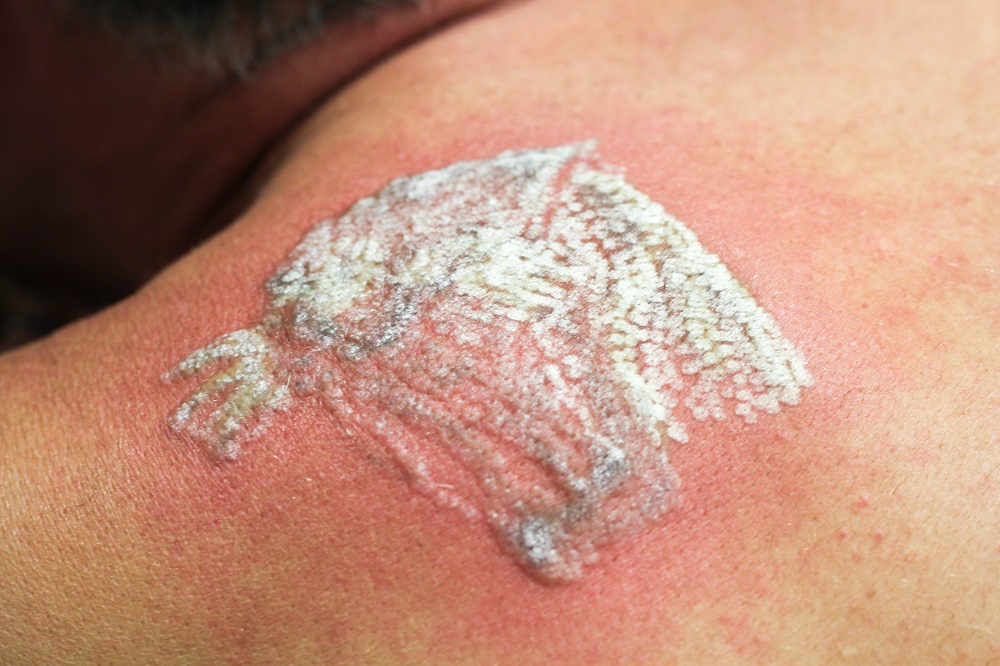
Frosting, enrojecimiento de la piel e hinchazón leve inmediatamente después de un tratamiento de desvanecimiento con tatuaje con láser. El enrojecimiento se manifiesta también en el área circundante del tatuaje tratado. Esta es una reacción normal a la quemadura causada por el tratamiento de desvanecimiento del tatuaje con láser.
Ciertos tratamientos de desvanecimiento como Láser, Plasma, IPL se basan en quemar el tatuaje para ayudar a desvanecerlo La formación de ampollas es una reacción fisiológica a cualquier tipo de quemadura; por lo tanto, cualquier tratamiento que cause una quemadura intencional de la piel conducirá a alguna forma de formación de ampollas. Por lo general las ampollas comienzan a formarse al día siguiente del tratamiento, reemplazando la inflamación menor y el enrojecimiento causado por la quemadura de la piel. La formación de ampollas no requiere ningún tratamiento y desaparecerá por sí sola. Con el fin de reducir la formación de ampollas y el tiempo de inactividad asociado con la quemadura causada por el tratamiento, se pueden utilizar bolsas de hielo y productos calmantes apropiados para aliviar los efectos adversos inmediatamente después del tratamiento de desvanecimiento del tatuaje. No se deben usar productos para empacar hielo y otros productos calmantes después de los tratamientos de atenuación de tatuajes con plasma. Esto se debe a que las experiencias de ampollas no son importantes después de usar Plasma.

Ampollas después del tratamiento de desvanecimiento con láser. Esta es una reacción fisiológica a varios tratamientos cutáneos con láser. Las ampollas no deben arrancarse a propósito.
Por lo tanto, la formación de ampollas es una reacción normal y una indicación de que el proceso de curación ha comenzado. Es posible que no se vean muy bonitos y que estén sensibles al tacto, pero las ampollas deben tardar entre 3 y 14 días en recuperarse por completo. Las ampollas no deben ser reventadas. Hacer estallar las ampollas a propósito puede interferir con el proceso de curación fisiológica, incluido el aumento de la probabilidad de infecciones , en consecuencia, la cicatrización permanente..
Otra señal más de que la eliminación de tatuajes está funcionando y la curación está teniendo lugar. La raspadura es una parte típica del proceso de curación después de ciertos tipos de procedimientos de desvanecimiento de tatuajes. El proceso de formación de costras comienza a desarrollarse dos o tres días después de los procedimientos de desvanecimiento del tatuaje con plasma (arcos voltaicos), Ósmosis y microdermoabrasión. Las costras a menudo contienen partículas de tinta fragmentadas. Cuando las costras se caen, la capa superior de la tinta se desprenderá con ella. Quitar o pelar las costras puede aumentar el riesgo de cicatrización, por lo que debe evitarse la tentación. Mucho dependerá del tamaño, el tipo, la intensidad del tratamiento y la ubicación del tatuaje, sin embargo, la mayoría de las costras se caerán por sí mismas dentro de dos semanas, siempre que no haya una infección inflamatoria en curso.

Los tatuajes comenzarán a picar tan pronto como comience el proceso de curación. Esto es generalmente una buena señal.
Esto debe verse como una buena señal, ya que el sistema inmunológico se activa y comienza a curar el área afectada, también es un signo de que no hay unainfección en curso.. Una sensación de picazón es común, pero al igual que cualquier otro tipo de irritación de la piel, el cliente no debe rascar el área tratada. Rascarse puede afectar la efectividad de la eliminación y, lo que es más importante, romper la piel y causar una herida, lo que podría aumentar la probabilidad de infección y cicatrización. En general, el cliente no debe aplicar cremas o lociones en el área tratada. Sin embargo, en caso de que la picazón se vuelva insoportable, el cliente debe consultar a un médico.

Las infecciones inflamatorias se pueden contraer durante el proceso de curación. Esto puede suceder después de cualquier tipo de tratamiento de desvanecimiento del tatuaje. Las infecciones también pueden causar cierto grado de hinchazón.
El sistema de defensa natural de nuestro cuerpo reaccionará a cosas como enfermedades o infecciones de varias maneras diferentes. Pero mientras que la hinchazón generalmente ocurre después de ser picada por un insecto u otras causas inflamatorias, también puede ocurrir después de someterse a tratamientos de desvanecimiento de tatuajes, especialmente debido a infecciones. Las infecciones inflamatorias se pueden contraer fácilmente durante el proceso de curación debido al hecho de que el área es una herida abierta y, como cualquier otra herida, está expuesta a varios tipos de bacterias que causan infecciones.

Las infecciones por tatuajes pueden manifestarse de varias maneras. A veces, el enrojecimiento es un signo de la aparición de una infección. Las infecciones inflamatorias son la causa principal de cicatrización permanente, cambio permanente en la textura de la piel y otras reacciones adversas permanentes..
Las infecciones inflamatorias son la principal causa de reacciones adversas permanentes como cicatrices y cambios permanentes en la textura de la piel. Después de la remoción de tatuajes con láser, es muy importante no reventar las ampollas (que se forman un par de días después del tratamiento) porque esto causa una herida abierta y pone al cliente en una mayor exposición a las infecciones. Por lo general, los riesgos de infecciones inflamatorias disminuyen tan pronto como comienzan a formarse las costras.. TLos riesgos de infecciones pueden minimizarse pero nunca evitarse por completo. La mejor manera de minimizar la posibilidad de contraer una infección inflamatoria durante el proceso de curación es mantener el área limpia y usar los productos antisépticos apropiados a intervalos regulares.
Reacciones adversas semipermanentes.
La reacción adversa semipermanente más común es un cambio temporal en la textura de la piel. Esta es una reacción normal al proceso de regeneración de la piel de los tratamientos de renovación de la piel. Como es bien sabido, después de los tratamientos de rejuvenecimiento de la piel, la nueva piel tiene un color rosado y una textura ligeramente diferente al resto de la piel. El color rosado se debe a la falta de pigmentación de la nueva piel. Con el tiempo, la textura de la piel se mezcla con el resto de la piel y se formarán nuevos pigmentos. Esto se aplica a todas las técnicas de desvanecimiento de tatuajes que se analizan en esta página web, incluido el desvanecimiento de tatuajes con láser..
En otros casos, en particular, con el uso de Ósmosis la reacción adversa semipermanente común en esos casos, especialmente cuando se produce una infección, es una cicatriz a menudo temporal. Esta cicatriz aumentada temporalmente suele durar de dos a tres meses y, en la mayoría de los casos, desaparecerá con el tiempo y el área se fusionará con la piel circundante.
Los tipos de reacciones adversas permanentes pueden ser: cicatrización (o cambio permanente en la textura de la piel), , formaciones de queloides , hiperpigmentación e hipopigmentación (reacción adversa asociada con los tratamientos con láser).. Estos tipos de efectos adversos permanentes pueden ocurrir a pesar del tipo de tratamiento de desvanecimiento del tatuaje realizado. En cualquier caso, la probabilidad de estos efectos adversos inherentes puede minimizarse pero nunca eliminarse por completo.
Cicatrización
La cicatrización permanente es un riesgo inherente a cualquier tipo de tratamiento de desvanecimiento del tatuaje, puede minimizarse pero nunca excluirse por completo. Rara vez se producen cicatrices permanentes debido al tratamiento de desvanecimiento del tatuaje solo. La cicatrización permanente a menudo es causada por el daño infligido por las infecciones contraídas durante la etapa de curación. Además, en el caso de los tratamientos de desvanecimiento con tatuajes con láser, las ampollas normales no deben reventarse a propósito, ya que esto también puede aumentar la probabilidad de complicaciones, especialmente infecciones. Si el tratamiento de desvanecimiento del tatuaje produce costras, las costras no deben recogerse y deben caerse por sí solas. Si se producen cicatrices, generalmente no es muy notable y se puede minimizar con aceite de vitamina E o con parches de silicona de venta libre..

Los riesgos inherentes de desarrollar un cambio permanente en la textura de la piel o cicatrización pueden minimizarse pero nunca eliminarse debido a la naturaleza misma de los tratamientos de desvanecimiento del tatuaje disponibles en la actualidad. Los riesgos de cicatrización aumentan dramáticamente si una infección se contrae durante el proceso de curación.
Los riesgos de cicatrización permanente nunca pueden eliminarse por completo, incluso si el procedimiento de desvanecimiento del tatuaje se lleva a cabo de manera adecuada y el cliente sigue rigurosamente las instrucciones de postratamiento. Esto se debe a que ciertos individuos son particularmente propensos a desarrollar algún tipo de cicatrización o diferencia permanente en la textura de la piel. Esta es una de las razones para realizar una prueba de parche en la etapa de consulta. Además, algunos individuos pueden ser propensos a desarrollar queloides, algunos incluso pueden no ser conscientes de esta predisposición..
Cualquier tratamiento de eliminación de tatuajes se basa en una forma de rejuvenecimiento de la piel, que se puede hacer usando lásers, arco eléctrico, peeligns químicos etc. Cuando la piel comienza su proceso de regeneración fisiológica y está expuesta a fuentes de luz UV, Tanto natural como artificial, la reacción normal de la piel puede ser una hiperpigmentación. Este tipo de hiperpigmentación es posible, no solo después de los tratamientos de desvanecimiento del tatuaje sino también después de cualquier otro tipo de rejuvenecimiento de la piel, incluidas las exfoliaciones cosméticas. Por lo tanto, los tatuajes cosméticos y el maquillaje permanente pueden oscurecerse después de los tratamientos de desvanecimiento del tatuaje. Aunque otros tratamientos de repavimentación pueden disipar la hiperpigmentación, la hiperpigmentación puede ser muy difícil de resolver a veces.

La hiperpigmentación es una reacción adversa posible después de cualquier tipo de tratamiento de desvanecimiento del tatuaje. La probabilidad de que esto ocurra aumenta si la persona expone el área tratada a fuentes UV y a la luz solar en general.
Lamentablemente, la hiperpigmentación es un riesgo inherente a cualquier tipo de tratamiento de rejuvenecimiento de la piel, por lo tanto, se puede minimizar, pero nunca descartar por completo después de los tratamientos de desvanecimiento del tatuaje. La mejor manera de minimizar la probabilidad de hiperpigmentación es evitar la exposición al sol, incluida cualquier fuente de luz UV. El uso de protector solar total hasta dos meses después del proceso de curación debe ser obligatorio. Tenga en cuenta que debe evitarse la exposición a la luz solar y al sol incluso durante el uso de la pantalla solar total hasta dos meses después del último tratamiento.
La hipopigmentación es una reacción adversa común a los tratamientos estéticos con láser en general (incluido el estiramiento de la piel, el rejuvenecimiento de la piel, etc.). Estos riesgos potenciales de este cambio permanente en la textura y el color se pueden minimizar pero nunca excluir después de los tratamientos estéticos con láser. La hipopigmentación es particularmente común en los tonos de piel más oscuros (seis, cinco y cuatro), sin embargo, se ha informado sobre tipos de piel más claros (incluidos uno y dos). Este tipo de reacción adversa prevalece solo después de los tratamientos de desvanecimiento con láser y son muy raros después de otros tipos de tratamientos de desvanecimiento del tatuaje.

Hipopigmentación después de la eliminación de tatuajes con láser. La hipopigmentación es una reacción adversa común a los tratamientos estéticos con láser en general. Son particularmente comunes en los tipos de piel más oscuros (cinco y seis), sin embargo, también se ha informado sobre tipos de piel más claros (incluidos uno y dos).
La hiperpigmentación se produce cuando la sobreproducción de la pigmentación se produce durante el proceso de curación; a la inversa, la hipopigmentación se produce cuando la pigmentación normal de la piel se ha eliminado y la nueva melanina no puede producirse de forma permanente o temporal. Por lo tanto, el efecto de hipo-pigmentación puede ser permanente o semipermanente. A veces puede tomar meses o incluso años para que el pigmento de su piel se vea normal nuevamente. Para algunas personas, la textura de la piel nunca puede ser la misma.
Como resultado de la hipopigmentación, se podrán ver partes más claras de la piel donde antes estaba el tatuaje y el láser trató la zona de la piel. Sin embargo, tanto la hiperpigmentación como la hipopigmentación son más tolerables que el tatuaje no deseado.
La mayoría de los tratamientos de eliminación de tatuajes se comercializan actualmente como tratamientos de eliminación de tatuajes.. Hasta la fecha, el único procedimiento que puede abordarse correctamente como la eliminación de tatuajes es la escisión quirúrgica. Solo la escisión quirúrgica del tatuaje cpuede garantizar la eliminación completa en una sola sesión, las otras técnicas pueden atenuar el tatuaje, sin embargo, la desaparición completa en una sesión no puede garantizarse. En la gran mayoría de los casos, se requieren varias sesiones para lograr un desvanecimiento satisfactorio del tatuaje. A veces, la eliminación completa (sin cicatrices) de los tatuajes no siempre es posible mediante el uso de técnicas de atenuación de tatuajes convencionales actualmente disponibles. En este caso, el encubrimiento del tatuaje puede ser una buena opción después de desvanecer el tatuaje tanto como sea posible con la mayoría de las técnicas de desvanecimiento del tatuaje disponibles.
Los clientes están interesados en tener una estimación de la cantidad de tratamientos requeridos para lograr los resultados deseados.. La cantidad de sesiones requeridas puede variar desde tan solo una en caso de eliminación de maquillaje permanente e incluso puede requerir hasta 10 o más sesiones en caso de tatuajes resistentes. La cantidad de sesiones requeridas también depende del tipo de tratamiento de desvanecimiento del tatuaje, así como la intensidad del tratamiento. Para realizar una estimación realista, se debe realizar una prueba de parche para extrapolar esta información del grado de desvanecimiento del tatuaje realizado después de la prueba de parche. Las pruebas de parches también revelan si el cliente puede ser susceptible a algún tipo particular de reacciones adversas permanentes inherentes al procedimiento de desvanecimiento del tatuaje en particular.
Si bien la eliminación de tatuajes con láser es actualmente el procedimiento más popular de "eliminación de tatuajes", también existen varios otros tratamientos efectivos para la eliminación de tatuajes (es decir, Plasma, Plasma y Osmosis, Osmosis asociada con otros tratamientos de dermabasion, microdermabrasión, IPL, peelings químicas, terapia de Cryterapia, etc.) . A pesar del método utilizado para atenuar los tatuajes, en el caso de una serie de sesiones de atenuación de tatuajes, el grado de atenuación de los tatuajes es solo la eliminación mínima de tatuajes por sustitución, puede ser la mejor opción.
[:]


